Subscribe to be the first to get new family travel inspiration Sign up today!

MUMMYTRAVELS
Can you really keep travelling with a child in tow?
Subscribe to be the first to get new family travel inspiration

A Great Fire of London walk with kids – visit Great Fire of London locations
Oh the miserable and calamitous spectacle! So wrote one eyewitness after the Great Fire of London in 1666, when a chance spark from a baker’s oven led to a four-day conflagration which burned down 13,000 homes and left around 100,000 of London’s inhabitants homeless.

contains affiliate links *
The fire, which saw the King and his brother manning the buckets, along with diarist Samuel Pepys, and cannon blasting houses down to create firebreaks, changed the face of the city forever. But if you visit London today, you can still discover some of the Great Fire of London locations – so with my daughter learning about it in class, we came up with a Great Fire of London walk to visit them.
Because if 17th century London with its wooden houses and narrow streets is a world away from today’s metropolis, there’s still plenty to discover in the city’s streets.
Great Fire of London Walk: Stop 1
Where else should you start but Pudding Lane, home to the bakery where the fire itself began. Conspiracy theories have abounded over the years but the first spark came from an oven belonging to Thomas Farynor or Farriner, whose family awakened to thick smoke in the middle of the night.
His maid was the first casualty of the fire when she refused to jump from the window – the final death toll was recorded at six, although it seems likely there were more.

Today Pudding Lane in the City of London is a fairly unexciting little street but there’s still a plaque marking the spot where the fire began – or at least ‘near this site’.
This particular one was added in 1986 although there is an original sign in the Museum of London collection.
While you’re here, keep an eye out for the concrete blocks marked with the lines of the children’s song London’s Burning – ‘London’s burning, London’s burning. Fetch the engines, fetch the engines. Fire fire! Fire fire! Pour on water, pour on water’.
Bonus marks if there are enough of you to sing it as a round.
Check out my four-page mini guide to the Great Fire of London , including quirky trivia and some more unexpected sites
Great Fire of London Walk: Stop 2
Just steps away is the most famous spot commemorating the fire – known simply as the Monument.
At the junction of Monument Street and Fish Street Hill, it was designed by Sir Christopher Wren and finished in 1677. The latest restorations were finished in 2009, with new golf leaf on the flaming orb at the top.
Standing 202 feet high, it’s 202 feet from the spot where the fire started on Pudding Lane – if you laid it down, it would reach right to the bakery.
As well as reading the plaque at the bottom, you can also climb the 311 steps to the gallery at the top to look out across the city.
There are Latin inscriptions on three sides of the monument – and one phrase was removed from the north panel in 1830 blaming the Catholics and ‘Popish frenzy’ for the fire.
Great Fire of London locations: Need to know
If you want to climb the Monument , with adult tickets costing £5.40, and £2.70 for children aged five to 15 (take cash to be on the safe side). You can also get joint tickets for the Monument and the Tower Bridge Exhibition, for £12.80 and £6.40, as well as family tickets.
It’s open daily from 9.30am-6pm, with last admission 30 minutes before closing and it’s closed entirely from December 24-26.
Only 33 people are allowed inside at any time, with a free certificate for those which make the climb. Needless to say, it gets very chilly on the top!
For more great views in London with kids , check out my other top picks

Great Fire of London Walk: Stop 3
Next, head west from the Monument towards St Paul’s Cathedral – one of the symbols of the rebuilt London and one of the iconic landmarks of the city.
On your way, keep an eye out for some of the other remnants of 17th century and medieval London, including the shields on the livery halls .
The original medieval St Paul’s was in a bad state of repair before the fire, damaged by a lightning strike which hit the nave and used as a stable during the English civil war.
Before the fire, no-one could agree whether to restore the original, demolish it completely or a compromise between the two… until the fire took the decision out of everyone’s hands.
The heat of the flames was so intense the stone cracked and exploded, even the lead on the roof melted. Some Londoners had taken shelter inside reasoning that stone wouldn’t burn as easily as the wooden houses, but the heat was too intense – not to mention the cathedral had a wooden roof.
Today it’s hard to imagine London’s skyline without Christopher Wren’s famous dome, one of the highest in the world, and you can visit except on Sundays or when it’s closed for special services – click here to book tickets .

Head to the Whispering gallery where a whisper on one side can be heard on the other – I remember doing this with my parents as a child, and it seems like magic that this should be possible.
There are two more galleries above with fabulous views if you’re happy to climb 528 steps. The Whispering Gallery is 259 steps, if you don’t fancy the complete climb.
You can also see tombs of famous Britons in the crypt, including Wren himself, Lord Wellington and Lord Nelson plus memorials to Florence Nightingale, Samuel Johnson and poet John Donne, the only one to have survived the fire.
If you don’t fancy going inside, you can walk around the outside to admire the dome, look at the statues and the churchyard – it’s also appeared in several films, from Mary Poppins to Harry Potter and the Half-Blood Prince.
If you do go in, Harry Potter fans can also see Wren’s Geometric Staircase in the south-west tower which appeared Harry Potter and the Prisoner of Azkaban.
Tickets to St Paul’s cathedral cost £20 for adults (or £17 online), and £8.50 for children (or £7.20 in advance) and visitors spend around two hours inside on average. Prebooking is recommended, with open-dated tickets currently available – check the latest information on whether you need a timed slot.
There are family tours as well as multimedia guides. If you’re a UK taxpayer, you can add gift aid to your purchase and get free entry for the rest of the year.
Great Fire of London Walk: Stop 4
Head north towards the Museum of London near Barbican on London Wall – a small part of the original Roman wall still remains nearby, and you can track all of London’s history in this free museum, from the earliest settlements to modern day.
EDIT: The museum is now temporarily closed until reopening in its new site at Smithfield in 2026
Stop at the family desk near the entrance and pick up the activity sheets – there’s one on the plague and Great Fire if you want to head straight to the gallery dedicated to this part of history.
If you’ve got time, there’s a separate rather chilling video display in an earlier gallery on the first appearance of the Black Death in the 14th century.

But the Great Fire exhibits alone are fascinating, with displays and another video telling the tale of the fire plus original artefacts.
Look up and you’ll see a fire hook suspended from the ceiling as well as a fire insurance symbol which would have been displayed outside houses.
There are also images of the houses, narrow at the bottom but wider at the top so neighbours could even shake hands through their windows without stretching (and which helped the flames leap from building to building) as well as examples of leather buckets and helmets to try on, and compare to more modern equivalents.
There’s also the original plaque which was displayed on Pudding Lane, and which puts the blame squarely on the Catholics in a plot to destroy the city, not to mention learning about the tale of the Frenchman Robert Hubert who was hanged for starting the fire, after confessing to it… despite not having done it.
It’s now accepted he was innocent, and was described as ‘not well in mind’.

Entry to the Museum of London is free – it’s worth noting that there is a separate Museum of London Docklands , with its own interesting galleries and temporary exhibitions so don’t get the two mixed up.
For more details on visiting London’s free museums with kids, check out this post .
You need to climb up to the pedestrian high walk from Aldersgate Street, London Wall or St Martin’s-le-Grand to get into the museum (there are lifts and escalators as well as stairs) and the museum is planning to move to a new home with more space in West Smithfield, intending to open there in 2022.
The Museum of London opening hours are 10am-6pm.
Great Fire of London Walk: Stop 5
Head west to Chancery Lane for one more remnant of medieval London which survived the great fire – you can walk back down to St Paul’s and take the tube one stop, or catch a bus, if legs are getting tired by this point.
Staple Inn is one of only four original Tudor timber-framed buildings left in the City of London – you’ll spot the black and white timbered building not far from the tube exit on High Holborn, which dates back to the mid 16th century.
The fire stopped just before it reached this point. The front was then hidden under fireproof plaster for centuries before being restored.
Great Fire of London locations: Want more?
For more original buildings, there’s also 41 Cloth Fair not far from the Barbican and Museum of London, the oldest house in the City of London, built some time between 1597 and 1614, which survived as it was protected by the thick priory walls of St Bartholomew’s nearby.
Not far away is St Bartholomew’s Gatehouse which also dates from the 16th century, although the stone below is even older – another survivor protected by the priory. You can also find more ideas scattered around London here .
Or head east towards the Tower of London to All Hallows by the Tower, the oldest church in the City of London – originally founded in the 7th century.
Samuel Pepys climbed its tower to watch how the fire was spreading, recording his observations in his famous diary – it survived only thanks to the firebreaks created when surrounding buildings were demolished.
If you’re in central London, head over to Goodwins Court, one of the old alleyways just off St Martin’s Lane, where you can spot a fire mark, a small gold and red crest high up on the wall – dating from around 40 years after the Great Fire, it was one of several showing your house was protected in case of fire, in the days before fire brigades.
Check out this post for my top 49 free things to do in London with kids , the best Roman sites in London and more unusual things to do in London with kids , as well as my self-guided walking tour of London’s landmarks
PIN FOR LATER: GREAT FIRE OF LONDON WALK

Disclosure: This post contains affiliate links – any purchases you make are unaffected but I may receive a small commission
Images copyright MummyTravels
Award-winning family travel blogger and mum to the mini traveller, aka Minnie. Together we've visited Europe, America, the Caribbean, Africa and Asia, tried a cruise and a road trip, and survived countless long-haul trips. London (UK) based. Serious beach habit.
12 Comments
My daughter’s just finished learning about the Great Fire of London too. I’ve bookmarked this for a historic walk – very helpful!
Pleasure! Hope you have a fun wander – I love being able to actually visit the sites from history, there’s just nothing like it.
where is the photo taken – first one with the words of London’s Burning, on blocks? is it at Museum of London? I’m taking a child who is obsessed with the story, on this walk .
It’s right between the Monument and Pudding Lane – just outside Aldermore Bank offices but you can’t miss them if you walk from Fish Street Hill past the Monument to Pudding Lane (or vice versa). Hope you have a great time on the walk and that it’s useful!
great! thank you for the information
Very good walk, thanks for the blog post
Thanks! Really glad it was helpful
Great write up doing this tomorrow and hoping to see an insurance fire marker at goodwin court too
Hope you had fun (and escaped the rain). And that’s brilliant, had forgotten about those little markers, a perfect add on for a Great Fire walk.
Brilliant and very helpful thank you. How long does the walk take?
My pleasure! Really glad it’s helpful – so you’ll probably want to allow around an hour purely for walking (unless your kids are particularly fast/slow, although you can shave some time off if you hop on a bus for the last stop). Then it just depends how long you spend at the various stops: eg if you decide to climb Monument, if you only visit the Great Fire section of the museum or the whole thing, if you go inside St Pauls and so on.
You could make a day of it if you go inside everything (plus lunch), or you could see all the essentials in a couple of hours.
Leave a Reply Cancel reply
Your email address will not be published. Required fields are marked *
This site uses Akismet to reduce spam. Learn how your comment data is processed .
Pudding Lane – The Great Fire of London
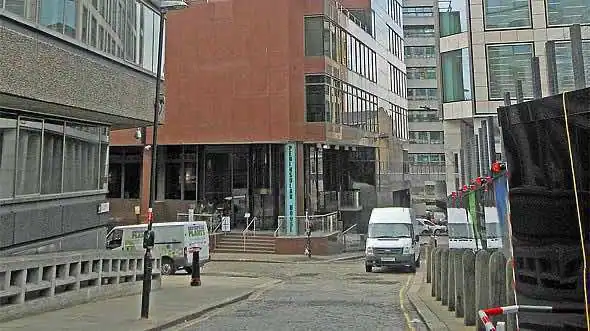
Good for kids? ★ ★ ★ Value for money? n/a Worth a visit? ★ ★ ★
“All the sky was a fiery aspect, like the top of a burning oven… 10,000 houses all in one flame; the noise and cracking and thunder of the impetuous flames, the shrieking of women and children, the fall of towers, houses and churches, was like a hideous storm, and the air all about so hot and inflamed that at the last one was not able to approach it, but forced to stand still and let the flames burn on.” John Evelyn, diarist (1666)
Craig ’s review… It’s not often that a lowly nobody like me gets the opportunity to change history, but if I was strolling down the river 350 years ago I could have smelt the burning buns and nipped into the bakers and said, “oy, mate… your cakes are on fire!” Because Thomas Faryner burnt more than his cakes that day – he burnt the entire city down to the ground.
The Great Fire of London, 1666
The most amazing thing to me is not that he did it, but that he somehow managed to get away with it scot-free. He swept up all of the cinders and kept his head down. He kept his mouth shut. He knew that sooner or later somebody would blame a foreigner, so imagine his relief when they started pointing their fingers at a Frenchman. And then imagine his guilt when they killed him.
The city… gone . People… dead . Mobs rampaging through the streets beating up the Catholics, attacking foreign nationals… thousands of Londoners destitute and desperate… Old St. Paul’s reduced to a pile of rubble. And all because he forgot to take his buns out of the oven. Nice one, Tom!
If you ask the experts to name two men who have made the biggest impact on London’s architecture then they’ll probably try and convince you that it was the classically trained Inigo Jones and Christopher Wren’s of this world, but deep down they know it was really a forgetful old baker and a homicidal maniac. Adolf Hitler wasted London with bombs – Tom did it with buns.
There’s nothing much to see in Pudding Lane nowadays other than The Monument next-door. It’s decorated with heavy metal shutters, courier bikes, concrete bollards and CCTV cameras. It might even be the ugliest street in London because the architecture is truly brutal. It’s post-war depresso – the kind of architecture that you really would want to burn down.
But I’m guessing that these buildings won’t burn because they’re all concrete, stone and steel. If the Great Fire of London sparked up again today then this street will still be standing, like the weevils at the end of a nuclear war.
It’s the kind of place that you pass through on the way to somewhere else. People have their heads bowed down as they amble down it, totally oblivious to the incredible history that once occurred here.
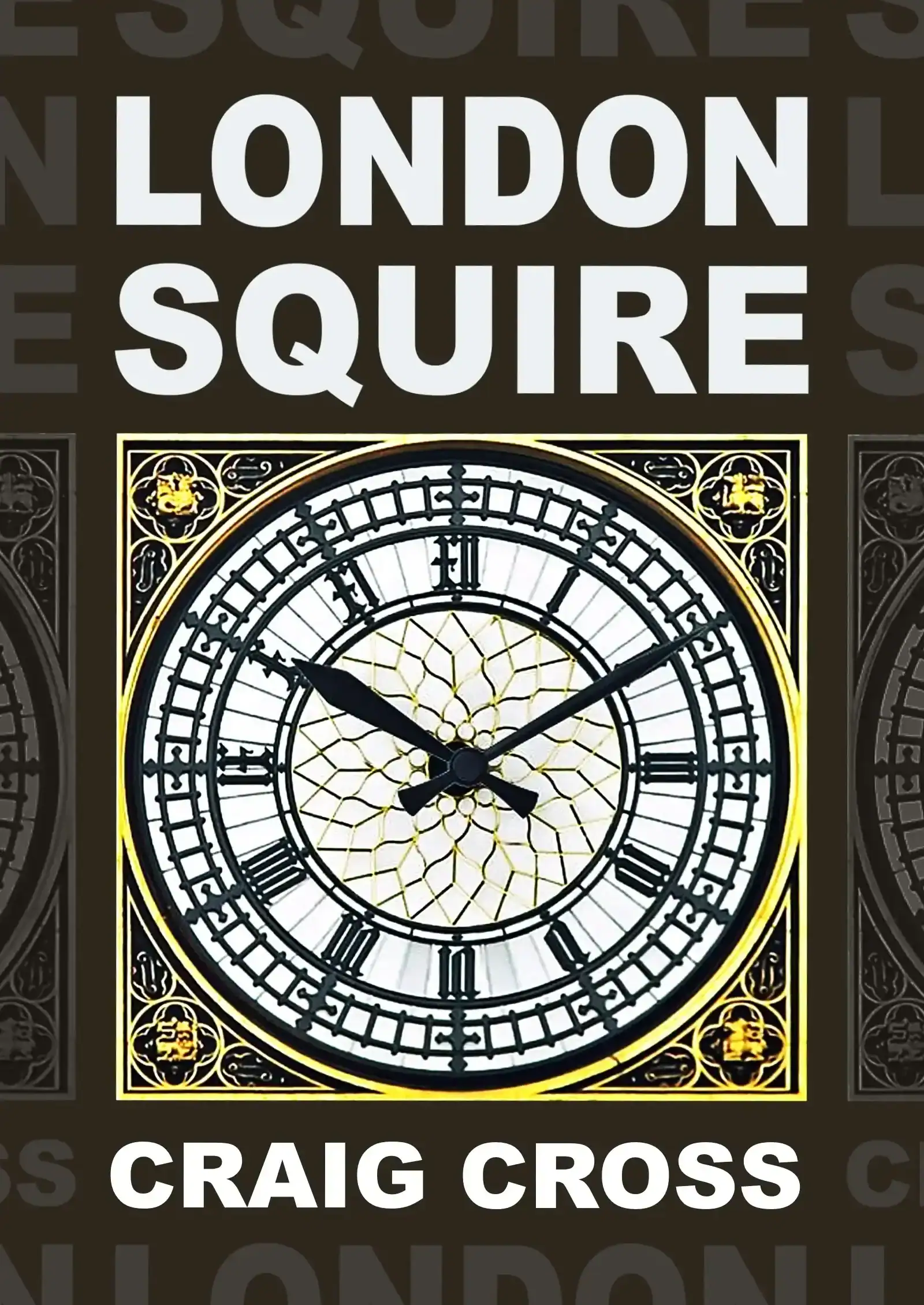
We also recommend… If you enjoy this then try The Monument (you can walk there in less than 1 min) . You can learn a lot more about the Fire at the Museum of London , and see some paintings of it at the Guildhall Art Gallery
Your comments and questions
DLong I'm interested in the fire of London and want to know whether they show the location of the bakers where the fire started
Craig Hi DLong. No, all they've really got is the plaque shown above which says "near this site". But I saw a program on the telly a while back which suggested that the fire didn't start in Pudding Lane at all. Faryner's shop was definitely in Pudding Lane, but the actual ovens were in the street nextdoor. So who knows!
You must enable javascript to leave a comment
> Forum: London Landmarks, Attractions & Events

Welcome to the Monument
The monument is one of the city of london’s most outstanding landmarks and visitor attractions, the monument stands at the junction of monument street and fish street hill in the city of london. it was built between 1671 and 1677 to commemorate the great fire of london and to celebrate the rebuilding of the city., learn more about the history of the monument and the great fire of 1666.

Introduction
The Monument stands at the junction of Monument Street and Fish Street Hill in the City of London.

Several incidents have taken place at the Monument during the passage of the years, some amusing, some daring and some tragic.

During the war
The Monument has undergone frequent repair and redecoration. In May 1834 it was completely renovated …

Sir Christopher Wren prepared several designs for the Monument and the selection and approval of his final design …
Sir Christopher Wren
Wren was an English scientist and mathematician and one of the country’s most distinguished architects, best known for the design of many London churches, including St Paul’s Cathedral. He was a founder of the Royal Society and his scientific work was highly regarded by Sir Isaac Newton.
In 2007, the Monument closed for an 18-month programme of improvements and repairs
The £4.5 million restoration project, funded by the city of london corporation, involved the cleaning and repair of the monument’s stonework and the re-gilding of it’s famous golden orb..

6 August 2008
The gilders applying some of the gold leaf to the gilded copper orb of the Monument.

Carver mason Mark Thompson making templates for repairs to the dragon wings.

6 February 2008
First close up look at the dragons and the growth of algae and lichen.

4 December 2008
The scaffolding has now been dismantled. Over the next few days the steel joists and the concrete base will be removed.
Visiting the Monument? Don't forget to tag us @themonumentinfo and we will share your tweet!
The monument on twitter.
Welcome to the official Monument website. You can learn everything you need to know about the history of the Monument and the Great Fire of London. The official Monument website offers great resources for visitors including schools, who want to learn more about the Great Fire of 1666.
© Copyright 2007-2023 www.themonument.info · Website Designed and Hosted by Harris Digital
- Tower Bridge Restoration
- Temple Bar Gate
- Southwark Bridge
- The Beasts of Bloomsbury
- St Lawrence Jewry Fountain
- Web Design Hertfordshire
- Web Design Hoddesdon
- Web Design Packages
- Web Design Stevenage
- Product Video Production
- Web Design Basildon
- Paper shredding services
- Window Cleaners in Kent
- Manchester Stone
- Paper Shredding in Cambridge (Cambs)
Web Design Royston , Web Design Potters Bar , Website Design Packages ,
- No. 1 Warehouse
- Trade Expansion
- London, Sugar & Slavery
- City and River
- First Port of Empire
- Warehouse of the World
- Docklands at War
- New Port, New City
- Mudlarks family gallery
- Fashion City
- Exhibitions and displays
- Walks, talks and tours
- Family events
- Easter holidays
- Museum accessibility
- Eating and drinking
- Group visits
The new museum coming in 2026 will be situated at the heart of the capital’s historic Smithfield area next to Farringdon. Until then, the fun continues at our Docklands museum!
- Conferences and meetings
- Dinners and receptions
- West Smithfield
Discover London Through History

East London and the popularity of gospel choirs
The Jubilee Singers sang for Queen Victoria in 1873, but gospel choirs became popular only in the 1960s. Now they often sing with icons like Madonna.

Rare books: What makes them special and how to care for them
What makes a book rare? Tips on identifying special books, storage and safe handling techniques to preserve these literary artefacts.

Music icons, Soho fashion streets & the Swinging 60s
From The Beatles to The Rolling Stones, and from Carnaby Street to West End, here’s how music and fashion were intrinsically linked in 1960s’ London.

Disability: A child’s perspective from 1950s’ London
These photos of disabled children in specialist schools in 1950s’ London attempt to fill a crucial gap in documenting our history.

Reach every London schoolchild

Celebrate the London collection

A new museum for London
- Memberships
- Corporate partnerships
- For families
- For schools
- Collections
- Get involved
The Great Fire of London 1666
On 2 September 1666, an event started that would change the face of London. The Great Fire broke out from a baker's house in Pudding Lane. By the time it was over four days later, much of the medieval city lay in smoking ruins. These objects from our collections tell the story of the Great Fire.
The Great Fire of London is one of the most well-known disasters in London's history. It began on 2 September 1666 and lasted just under five days. One-third of London was destroyed and about 100,000 people were made homeless. The fire started at 1am on Sunday morning in Thomas Farriner's bakery on Pudding Lane. It may have been caused by a spark from his oven falling onto a pile of fuel nearby. The fire spread easily because London was very dry after a long, hot summer. The area around Pudding Lane was full of warehouses containing highly flammable things like timber, rope and oil. A very strong easterly wind blew the fire from house to house in the narrow streets. As the fire was spreading so quickly most Londoners concentrated on escaping rather than fighting the fire. They rescued as many of their belongings as they could carry and fled. Thomas Farriner and his family had to climb out of an upstairs window and onto their neighbour's roof to escape the fire in their bakery. There was no fire brigade in London in 1666 so Londoners themselves had to fight the fire, helped by local soldiers. They used buckets of water, water squirts and fire hooks. Equipment was stored in local churches. The best way to stop the fire was to pull down houses with hooks to make gaps or 'fire breaks'. This was difficult because the wind forced the fire across any gaps created. The mayor, Thomas Bludworth, complained, 'the fire overtakes us faster than we can do it.' A quicker way of demolishing houses was to blow them up with gunpowder, but this technique wasn't used until the third day of the fire (Tuesday 4 September). Fire Posts, each staffed by 130 men, were set up around the City to fight the blaze. On Tuesday night the wind dropped and the fire-fighters finally gained control. By dawn on Thursday the fire was out. The damage caused by the Great Fire was immense: 436 acres of London were destroyed, including 13,200 houses and 87 out of 109 churches. Some places still smouldered for months afterwards. Only 51 churches and about 9000 houses were rebuilt. St Paul's Cathedral was ruined, as was the Guildhall and 52 livery company halls. It took nearly 50 years to rebuild the burnt area of London. St Paul's Cathedral was not completed until 1711. Throughout 1667 people cleared rubble and surveyed the burnt area. Much time was spent planning new street layouts and drawing up new building regulations. By the end of the year, only 150 new houses had been built. Public buildings, like churches, were paid for with money from a new coal tax. The new regulations were designed to prevent such a disaster happening again. Houses now had to be faced in brick instead of wood. Some streets were widened and two new streets were created. Pavements and new sewers were laid, and London's quaysides were improved. The results were noticeable: '(London) is not only the finest, but the most healthy city in the world', said one proud Londoner.
Enjoy reading that? you might also like...

Samuel Pepys's silver plate
What does Sam's silverware tell us about Pepys and his times?

Little Londoners: strange and delightful dolls
Five fantastic and weird dolls discovered in our fashion collections.
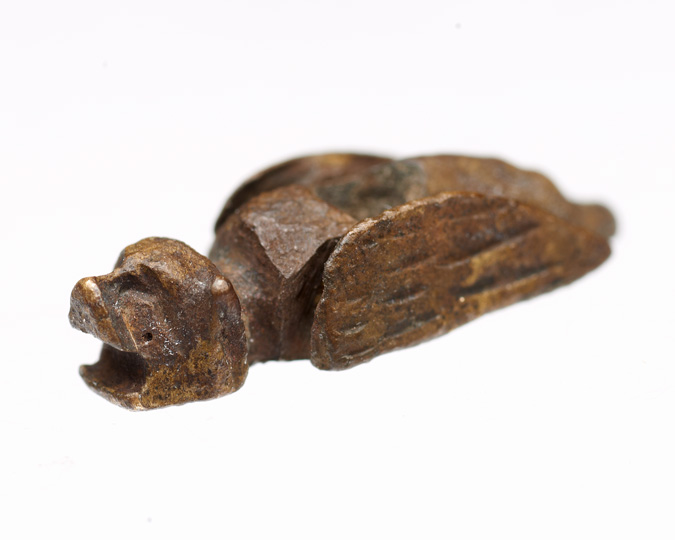
The Smallest Dragon in London
Matthew Russell tells us about a dragon smaller than a five pence coin from the collection.
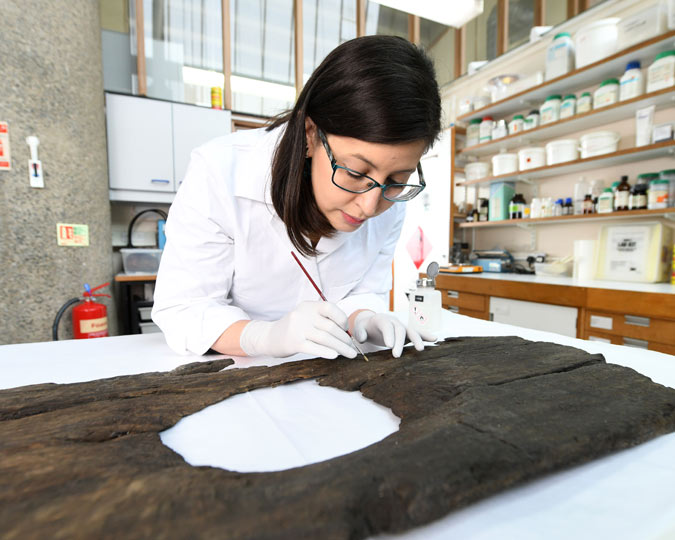
The triple threat: this medieval toilet seats three
A communal toilet seat from the 12th century reveals the underside of life in medieval London.
Be the first to hear about new exhibitions and events
Please enter a valid first name
Please enter a valid last name
Please enter a valid email address

VISITING THE MONUMENT TO THE GREAT FIRE OF LONDON
The Great Fire of London in 1666 was a cataclysmic event for the city, changing the face of the capital forever. Just five years later, at the place where it started, a monument was built to commemorate the event and to celebrate the re-building of the city. Designed by renowned architect Sir Christopher Wren who played such a huge part in re-building the city, this single column with a viewing platform is still open to visitors who can climb to the top to admire the views and learn more about the event.

A Brief History of the Monument
As most people know, Pudding Lane is where it all began, when a fire started in a bakery shortly after midnight on 2nd September 1666. Due to the overcrowding of largely wooden buildings, a strong easterly wind and the inaction of the Mayor, the fire spread swiftly throughout the city and soon engulfed most of the buildings within the Roman city walls. It took some time for people to demolish buildings to create firebreaks, by which time the fire had burned for 4 days.
The fire destroyed nearly 20% of the buildings within the city, including St. Paul's Cathedral, 87 churches, 13,500 homes, prisons, city gates and countless other buildings.
As part of the re-building, it was decided to build a permanent memorial to the event near the place where it began. Sir Christopher Wren, the King's Surveyor and architect who rebuilt St. Paul's Cathedral and 51 of the churches, joined forces with Dr. Robert Hooke and together they designed the monument.
It is a single Doric column of Portland Stone, with a spiral staircase of 311 steps which lead to a viewing platform, which is topped by a drum and copper urn with flames coming out, to symbolise the fire. It is exactly 61 metres tall, which is the distance between its base and where the fire started out.
It originally had a dual purpose and was intended to be used as an observatory and for scientific experiments as a giant zenith telescope. There is a small laboratory underneath the entrance but the vibrations from the endless traffic in the area meant that they had to stop, and so it became just a memorial and visitor attraction. Sadly the laboratory is not open to the public.
Visiting the Monument to the Great Fire
You can't pre-book your visit, you just show up when it is open and join the queue. There is a limit on how many people they can allow in at any one time as space is so limited, and the stairs are so narrow, but you are unlikely to find huge queues and can always wander off to look at other things while you wait for the queue to diminish.
The stairs are narrow and quite a tough climb; by the end I was one of a few people having to rest, puffing and panting, before we could continue on. The interior is very plain, just smooth stone walls and steps with a single iron handrail. There are a few small windows and several arched recesses where you can 'pull over' to rest or to allow others to pass. Keep an eye out for some old graffiti if you can - the oldest I found was 'THD' who hacked out his initials in 1792.
It is worth the climb once you get to the top, with some interesting views over the city. The whole platform is covered in a wire net though, so you have to stick your camera through the gaps to take decent photos of the views. The viewing platform used to just have a mid-height balcony around it, but it led to several deaths, one by accident and the others by design. The final suicide of Jane Cooper, a servant-girl, in August 1842, led to the construction of a wire cage around the viewing platform, which is what surrounds you today.
Although the immediate views tend to be of some rather boring office blocks, slightly further away you can also see the Thames, Tower Bridge , the Shard and the 'Walkie-Talkie' building which has its own viewing platform in the Skygarden .
After you have descended the spiral staircase, you are presented with a certificate as you exit. The outside of the monument is interesting too - the south side has a frieze showing the destruction of the city with Charles II and his brother James II directing the restoration of the city surrounded by representations of science, architecture and liberty.
The other sides have inscriptions. On the south side is a lengthy inscription in Latin glorifying Charles II and his munificence in rebuilding St. Paul's and London better than before, ' whilst the ruins were yet smoking [he] provided for the comfort of his citizens, and the ornament of his city; remitted their taxes, ... passed an Act, that public works should be restored to greater beauty. ... Haste is seen everywhere, London rises again, whether with greater speed or greater magnificence is doubtful, three short years complete that which was considered the work of an age."
The East panel is a list of the Mayors who were in office during the building of the monument.
On the north panel is a detailed description of the fire, where it began, how much was lost, how long it laste d, 'Merciless to the wealth and estates of the citizens, it was harmless to their lives, so as throughout to remind us of the final destruction of the world by fire.'
Ten years after its construction an extra line was added at the end of the inscription, blaming the start of the fire on a Popish plot, "But Popish frenzy, which wrought such horrors, is not yet quenched." This was the conspiracy theory of the day, that of a Catholic plot to kill Charles II. Instigated by one man, the conspiracy led to the execution of 22 others before the hysteria subsided. The last line was finally removed from the inscription in 1830.
Pudding Lane
There is a plaque on the wall showing the approximate place of the original bakery that started it all. Owned by Thomas Farriner who lived above it, he was woken up by smoke coming under his door and realised that his house was on fire. He and his daughter escaped through the window but his maid refused to follow and was the first casualty of the fire. The plaque was installed in 1986 by the Worshipful Company of Bakers.
The exact spot of the oven where it started was discovered in 2016 by archaeologists. It is in the southern lane of what is now Monument Street, about 60ft east of Pudding Lane, but which was once a part of the original Pudding Lane.
Incidentally, the Pudding in Pudding Lane does not refer to sweet treats, but to blood pudding - the offal from butchers cuts. The lane was in the centre of the meat district and was the route used to take all of the offcuts to the waste barges on the Thames.
There is also a plaque to St.Margaret Fish Street Hill, one of many churches which was destroyed in the fire. It was once famous for the amount of relics it held, which were said to include 'fragments of “the bush of Moses”, “the rod of Moses wherewith he divided the Red Sea”, “the manger that our Lord Jesus Christ was laid in”, “the clothing of St Mary the Mother of Christ Jesus” and “the stone whereon Mary Magdalene did her penance”. ( source ) The church was never rebuilt, the congregation merging with the nearby St Magnus the Martyr.
A recent addition to the area are some stone benches with the words of the famous rhyme 'London's Burning' engraved on the sides. Rather concrete and utilitarian, they nevertheless provide a good place to sit to admire the monument.
Visiting the Monument to the Great Fire of London
Postcode: EC3R 8AH
w3w: trendy.custom.swim
Nearest tube station: Monument
Opening hours: 9.30am - 6pm. (It closes for an hour at lunch - 1-2pm)
Prices: Adult: £5.40, Child (5-15 years): £2.70 Under 5s: Free
Related Posts
THE SHERLOCK HOLMES MUSEUM, LONDON
FITZROY HOUSE, LONDON: OFFICE OF AUTHOR L. RON HUBBARD
ST. DUNSTAN IN THE EAST: A MICROCOSM OF LONDON'S DESTRUCTIVE HISTORY
Opmerkingen
A family day out
Family reviews of attractions, events, walks and cycle rides, mostly in the UK.
The great fire of London walk
Both of my kids enjoyed learning about the great fire of London at school. We visited some of the places below when the kids were younger but as they were both eager to revisit the Monument I devised a themed ‘Great fire of London’ day.
Museum of London
We started with a visit to the Museum of London to see their Plague and Fire gallery. The best place to begin is by watching the 6 minute video which gives an overview of the fire and a day by day account from some of the eye witnesses. You might also like to pick up the War, Plague and Fire family activity sheet from reception (or download in advance from their website).
Afterwards take a walk around the gallery and see some of the objects relating to the fire. Our favourites were smoke blackened tiles unearthed in a cellar in Pudding Lane back in the 1970s. You can also try on a fire fighters leather helmet and compare it with our modern day equivalent.
St Paul’s cathedral

After leaving the museum we walked to the Monument past St Paul’s cathedral. The previous cathedral, known as Old St Paul’s, was one of the casualties of the fire. Many people had put their belongings into the crypt, believing they’d be safe from the fire but sadly it was not to be and the cathedral burnt. The current cathedral was designed by Sir Christopher Wren and rebuilt after the fire once attempts to restore Old St Paul’s were stopped.
We’ve visited St Paul’s Cathedral before so didn’t go in this time but if you’ve never been it’s worth it for the climb up to the Golden Gallery. It’s not cheap but you can get slightly reduced prices by buying tickets online.
Monument to the Great Fire of London

On to the Monument, which was designed by Wren and his colleague Dr Hooke, as a memorial to the Great Fire. This stone column is 61.5 metres high which is the exact distance from its location to the start of the fire. It’s fun to climb the 311 steps to the top and take in the view over London although you may need to queue for a while to get in.

The view had changed significantly since I last climbed the Monument as the new Walkie Talkie skyscraper now dominates the area! You can always pretend it’s not there and look out to the Thames and Tower Bridge instead. There is wire fencing all around the viewing area which can make it a little tricky to take photographs (hence no photo of the Walkie Talkie) but at least you’re safe.
Once you’ve squeezed back down the stairs you can pick up a free certificate to show you’ve climbed the Monument.
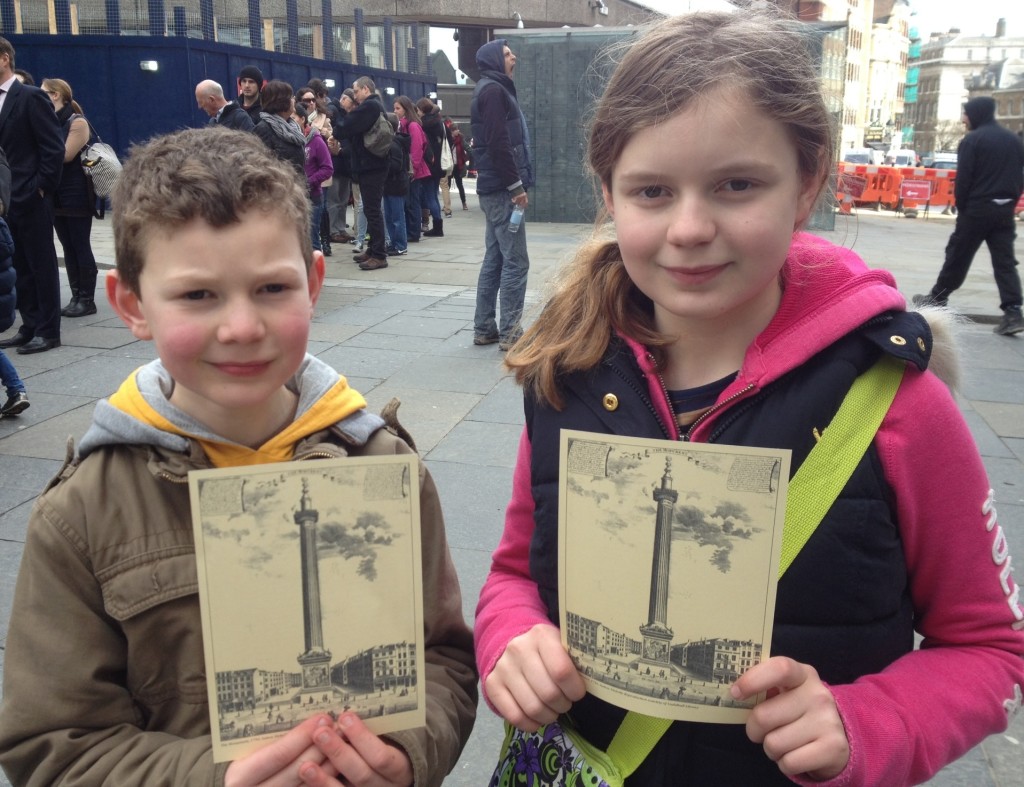
Pudding Lane
Just down the road from the Monument is Pudding Lane, the source of the great fire. The only reminder nowadays is a small plaque on one of the buildings. The road itself is nothing special, I think a new bakery would be a great addition!

All Hallows by the Tower
All Hallows by the Tower is the oldest church in London. It’s location next to the Tower of London means that it received plenty of beheaded bodies from the executions.
It’s also the church where Samuel Pepys climbed the tower to view the progress of the great fire. The church survived thanks to surrounding buildings being demolished to create firebreaks. It didn’t fare so well in the second world war though and in the crypt you can see lead which melted from the roof during the bombings. In the under croft you can also find an excavated Roman pavement, dating from the second century.
We finished our tour with a quick trip to Borough Market. This has a tenuous link of existing at the same time as the great fire, but we only really visited for its yummy food!
- The Museum of London is free although a donation is appreciated. The museum is open daily from 10am-6pm. It’s a short walk from either Barbican or St Paul’s underground stations.
- The Monumen t costs £4 for adults, £2 for children. The stairs are the only way to get up and the staircase is pretty narrow, as is the viewing platform. It can be a bit of a squeeze when trying to pass people. I wouldn’t personally recommend it if you have pre-school children but we did see a few being carried up.
- All Hallows by the Tower is free to enter. It’s open 7 days a week except during services. The nearest tube station is Tower Hill.
64 thoughts on “The great fire of London walk”
Looks like a fun day. You were able to visit a lot of place in London that i dream of seeing =) #Letkidsbekids
Thanks Merlinda, I hope you get to visit sometime as well.
Wow looks like a great day – I had no idea you could go up to the top of the monument – what a view! I love history and look forward to having lost of historical fun and day trips like this when the kiddies are older! Great post 🙂 xx #letkidsbekids
Thanks Caroline, it’s one of the cheaper views in London but you can still see loads.
I like the idea of combining education with an outdoor excursion. I learnt a few things by reading your post! #LetKidsBeKids
Thanks Tarana – I learnt a few things when I was researching the day out too.
What a great idea to do a fire of London tour. Fun and educational 🙂 Thanks for linking #LetKidsBeKids
Thanks Karen. Yes, they never knew they were learning!
Sounds like you had a great day! Love the certificates 🙂
Thanks Sharon, they were very proud of their certificates.
So,glad i found this post, my daughter is currently learning about tgfol, we have booked a day out in London and definitely going to follow these recommendations. Could you please tell me how far away from each other the things are, are they walkable etc. Any other info would be grateful. Thanks
Hi Anthony, hope you enjoy your day out! The great fire affected a relatively small area of London so yes, it’s all walkable.
I used to walk past monument all the time, but I have never climbed it 🙂 I bet the views are wonderful x #LetKidsBeKids
I’d been past it a few times as well Sara and didn’t realise its significance at the time. So I’ve learnt new things from the kids 🙂
What a fabulous post. I must admit to not knowing about the Monument but now that I do it will definitely be on our ‘to do ‘ list. I am a big advocate of hands on learning as I find that my own children learn best when they are able to use their senses to find out about a topic. We use a time machine to learn about history for example.
Thank you so much for linking up to the #BigKid list and I do hope to find out more about your inspirational ideas on the next one:)
Many thanks, glad you found it useful and hope you manage to visit when you’re next in London.
I never knew there was a monument to the Great Fire, less till that you could go up it! Bet it was tiring going up! #LetKidsbeKids
It wasn’t too bad going up but I did get cramp in my leg coming back down (as I always do on winding staircases).
That looks a really great day out. My youngest has been learning about the the great fire of London at school this week 🙂 x
Thanks Kim. I think it’s an eternally popular school topic.
I love historical outings, looks like you had a great day! #PoCoLo
Thank you, it was fun.
This is a fab post and totally relevant to us as Grace is learning about this too! I wonder if they think adding a bakery to Pudding Lane is bad luck?! Thank you for linking to PoCoLo, I think we will have to take a climb of the monument next time we are there 🙂 x
Thanks Vicky. I think a bakery would go down a treat with the tourists on Pudding Lane!
Grace says – Wow – what a fun and interesting day you had. I would love to visit the monument but it looks REALLY high xx #pocolo
Thanks Grace. It is high and you need to be quite fit to walk up all the stairs but there’s a great view from the top!
I love the story of the Fire of London. It started when we were little and my nan took us on a open top bus tour of London. Really loved reading this post #pocolo
Thanks Lucas. The open top bus tour sounds fun, perhaps I need to do this on my next visit!
Monument is my favourite bit of this. Ask 100 Londoners what it’s a monument to, and I reckon less than 10 would know!
I must admit Eleanor that until my eldest studied the great fire I didn’t know either! (Well, I’m sure I did as a kid, but had probably forgotten).
Brilliant! I did this to reacquaint myself with old London as part of a paper for my History degree . I loved it! #MBPW
Thanks Kate, it’s great to make history come alive.
My year 2 son has the plague and fire as his topic this half term and I’m planning to take him into London this weekend and have been looking for ideas. This article has been very inspirational. Thank you.
I’m so glad it has helped! I hope you have a great day out in London.
What a great tour – I shall definitely be doing this when my daughter is a bit older (don’t think she’d love walking up all those steps at The Monument). I love learning more about the history of London. It’s shocking how much the Great Fire destroyed in London. Thank you so much for linking up to #citytripping
Thank you. I’m rather ashamed sometimes at how little history I remember from my school days so it’s as much fun for me to visit places like this as I always learn something new.
Great tips! I remember climbing the monument – my claustrophobia and acrophobia helping me all the way :))
It’s a tight squeeze in the Monument so you must have loved it, not!!!
I love this idea for a day out – shall have to remember it for a few years’ time when my daughter is old enough to appreciate it. I love the Monument but haven’t been up for absolutely ages. Thanks for linking up to #citytripping too
I think most children learn about the Great Fire in year 2 so that’s an ideal age to visit. I remember my son’s school making London out of cardboard boxes in the playground and then setting fire to them as if it were the great fire (all H&S controlled of course!)
I love the idea of doing a themed walk for your kids! I live in London so was really nice reading about all these places and there were a few things I learned as well here 🙂 when my daughter gets older ill do us some sort of a themed walk too, love how educational that could be 🙂 #citytripping
I keep on meaning to do some more themed visits to London but haven’t quite got around to organising them yet!
We loved the Monument when we went – it’s good value isn’t it, and the views are worth it too. I work opposite Borough Market, so can quite see why you ended up there! Love this idea of a themed trip. #citytripping
Yes, one of the cheapest views in London (although getting a little overshadowed now). I first went up about 7 years or so ago and it’s amazing how London’s skyline has become much more high rise in a relatively short timescale.
Proud to say I have done the Monument climb, many, many moons ago (in fact the year probably started with a 19…) wish I kept my certificate! well another excuse somewhere to take the kids in years to come. #citytripping
I have 2 certificates – but I’m not sure where either of them are!
What a great tour! My friend’s daughter is doing the Great Fire of London at the moment. I’ll send her a link to this 🙂 #citytripping
Thanks Claire, I hope it’s of use.
Oh splendid! You have totally just planned a future day out in London for me! My son ‘did’ the Great fire at school, but for some reason we never bothered to wander around the sights. I doubt I’d have found all Hallows, though, and that would have been a shame. Cool!
It’s good to bring history alive. Although sometimes hard to imagine how it would have been given the surrounding of the Monument/Pudding Lane nowadays.
- Pingback: City Tripping #2 - Wander Mum
Fab post! I’m going to do this with my kids! They love learning about the Fire of London! x
How long was the visit to the monument?
Hi Gage, I’d allow 20-30 minutes for the actual visit but you might also need to queue to get in if you visit on a busy day (school holidays).
What a fab post, you’ve totally inspired me – my eldest starts year 2 in September & will be learning about the Fire of London so we’re heading into London tomorrow to see the sights you mention!
Hi – found your post as was searching for Great Fire of London activities – my son’s next half term theme is GFoL. I’ve since booked our train tickets to London for a day trip in Nov following your route. I think I’m more excited than my boys! Xx
Hi Julia – hope you all have fun, I’m sure the boys will enjoy it too!
This has been really helpful – thanks! Planning a GFoL day out tommorow – looking forward to it!
Glad you liked it – enjoy your trip!
This was so helpful. We did your trail today as my daughter is obsessed with the fire, Samuel Pepys etc. They both loved it! Thank you. Great post x
Hi Susannah, thank you for your kind words, glad to hear they enjoyed it!
- Pingback: The 11 Best London Teaching Resources on Your Doorstep | Teach Lambeth
Fab post Travelling from the north west this week to spend a day with my two girls learning Tgfol is high on our tour list Thank you
Glad you enjoyed it Phil, have a great trip!
Leave a Reply Cancel reply
Your email address will not be published. Required fields are marked *
Save my name, email, and website in this browser for the next time I comment.
This site uses Akismet to reduce spam. Learn how your comment data is processed .
The Monument: Top Tips And Visitor Information
Explore the tallest isolated column in the world
TripSavvy / Christopher Larson
The Monument in the City of London was built by Sir Christopher Wren in 1667 after the Great Fire of London to send out the message that the "city would soon rise again." Visitors that make the climb to the top are rewarded with a 360-degree panoramic view of London.
The History
Sir Christopher Wren's flame-topped Monument to the Great Fire of 1666 is the tallest isolated stone column in the world. Completed in 1677, The Monument stands 202 feet high (61 meters) and is positioned 202 feet (61 meters) from the spot on Pudding Lane where the Great Fire of London is believed to have started.
How to Reach the Top
There is no elevator/lift so the only way to the top of The Monument is to climb the 311 spiral steps. It is a narrow staircase and there is nowhere to stop and rest. Plus, you come down the same way, so be prepared to pass other visitors going in the opposite direction.
Note: You don't actually climb right to the top as there is a gilded golden orb at the very top. Visitors can reach heights of 160 feet at the viewing "cage" and the very top measures 202 feet.
The Monument Review
The Monument reopened in February 2009 after an extensive restoration. There is now a pavilion with public bathrooms and facilities for staff at ground level.
It can get crowded at the top; don't try to stay for too long but do have a look out from all sides. As you would expect, there's not much room up at the top but you can pass each other if everyone breathes in. There aren't many iconic views but you can see Tower Bridge .
If you enjoy these vistas, consider visiting Up at The O2 , The London Eye and the St Paul's Cathedral Galleries .
Top Tips When Visiting The Monument
Prepare ahead to make your visit seamless:
- Don't take a large bag as it makes it harder to pass other people on the stairs. Leave bags with a friend at the bottom (there is no cloakroom) or simply don't bring much with you when visiting.
- Do bring your camera as you will get to enjoy some fantastic views from the gallery "cage" at the top. Put your camera in your pocket or around your neck as you will need your hands free to hold onto the railings when you climb up and down.
- There are talking telescopes in the "cage" to let you know what you can see.
- Don't give up as those who climb all the way to the top (and back down again) receive a certificate!
Visitor Information
The Monument is located at the north end of London Bridge at the junction of Monument Street and Fish Street Hill, 61 meters from where the Great Fire of London started in 1666.
Address: The Monument, Monument Street, London EC3R 8AH
Nearest Tube stations: Monument (District and Circle lines) and London Bridge (Northern and Jubilee lines)
Telephone: 020 7626 2717
Tickets: £4.50 per adult. £2.30 per child aged 5 to 15. There are combination tickets available for the Monument and the Tower Bridge Exhibition. Check current prices on the official website .
Hours: Open daily from 09.30 to 17.30 (last admission 17.00)
Visit Duration: 1 hour
Tallest Attractions Found in London
Sightseeing on the Number 11 London Bus
Guide to St Paul's Cathedral
Kew Gardens Visitor Information
St Paul's Cathedral
13 "Harry Potter" Filming Locations in London
Stay Cheaper By Staying Close to - Not in - London
10 Things to Do in London for £10 or Less
London's Tower Bridge: The Complete Guide
Camden Markets - The Complete Guide
Top UK Destinations for Stone Circles and Ancient Sites
26 Free Things to Do in London, England with Kids
Les Invalides in Paris: The Complete Guide
Top 20 Most Popular UK Cities for International Visitors
Climbing the Dome at St Paul's Cathedral in London
17 Best Romantic Things to Do in the United Kingdom
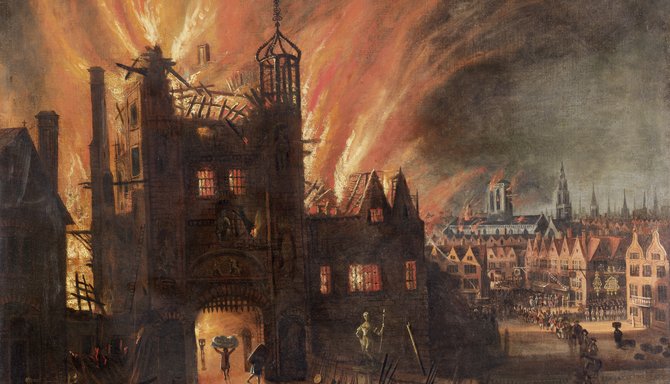
Pudding Lane
London, england.
A street named not for sweets but for animal guts, Pudding Lane is the site of Farriner's bakery, where the Great Fire of London began in 1666.
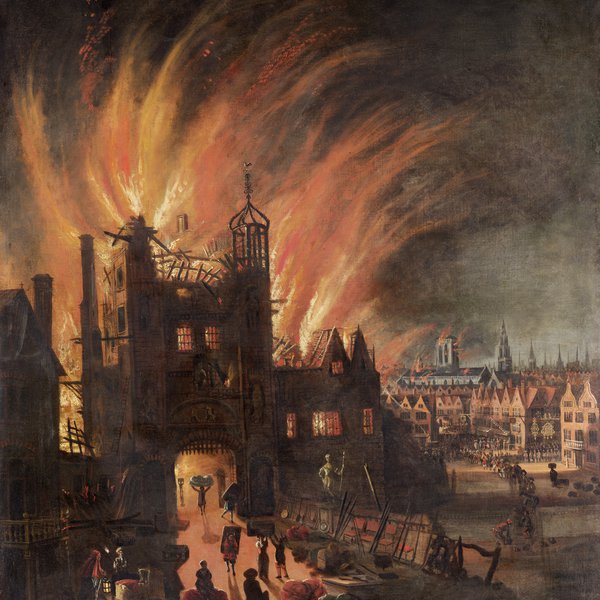
Fire Starts At Pudding Lane
A small London street between Eastcheap and Thames Street, Pudding Lane was made infamous in 1666 when Thomas Farriner's bakery caught alight in a blaze that would go on to destroy 85% of medieval London.
It was around midnight on the 2nd of September when the fire first started to spread. The best firefighting practices of the time would have had officials demolish buildings to create firebreaks, but the Lord Mayor hesitated. By the time he gave the go-ahead, it was already too late. The wind had fanned the flames into a full-blown firestorm.
The fire spread throughout the city and with it paranoia. Rumours spread of suspicious foreigners starting new blazes. French and Dutch civilians were set upon by the newly homeless. Chaos ensued.
For four days the fire raged. When at last it had been extinguished the city was unrecognisable.
13,200 houses, 87 parish churches, 52 livery company halls, the Guildhall, Royal Exchange and St Paul's Cathedral had all been destroyed by the fire.
About ten years later a monument was erected to commemorate the disaster. This can still be seen today, just off Pudding Lane, on Monument Street.

Road Regulations Also Start At Pudding Lane
The Great Fire of London isn't the only thing Puddling Lane is remembered for. It is also known for being one of the first one-way streets in the world.
In 1617, almost 50 years before the fire, a traffic order was issued designating it and 16 other nearby streets as zones in which traffic could only move in one direction.
London's First Building Regulations Are Introduced
Before Pudding Lane set London alight, there were very few building restrictions in place in London. In the aftermath of the fire, King Charles II immediately passed the 1667 Rebuilding Act, laws which were put in place to protect people and property in the event of another fire.
The act stated that there were to be no hanging signs, that all buildings in London were to be built using brick or stone and all dwellings should have easy access to water.
All buildings in London are still subject to the rules of the 1667 Rebuilding Act - except one. In 1996, when Shakespeare's Globe was rebuilt, the laws were waived to accommodate the iconic thatched roof. The roof has an elaborate network of sprinklers in use a fire starts.
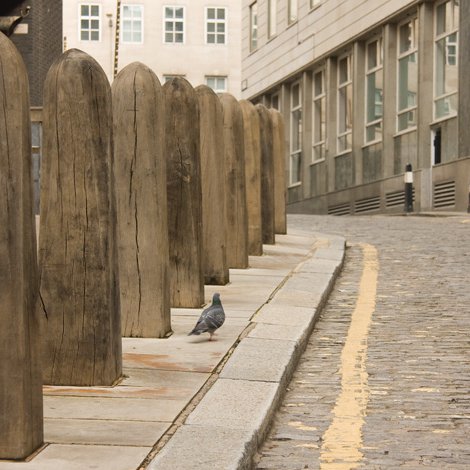
The 'Pudding' Of Pudding Lane
One might think the eponymous 'pudding' to be in some way related to Farriner's fateful bakery, but, much like The Shambles , it is actually derived from animal guts.
The word 'pudding' is taken from the Old French word for blood sausage, 'boudin', medieval puddings having primarily been made of blood and guts.
Pudding Lane gets its name from its proximity to Eastcheap, which was a meat market in medieval London. Carts would ferry (in one direction) animal guts away from the market, down Pudding Lane, to rubbish barges waiting on the Thames.

Fire Insurance Becomes Available
Pudding Lane was the catalyst for many 'firsts' in London.
Following the Great Fire, business-savvy entrepreneurs saw a gap in the market for fire insurance. The cost of rebuilding London after the fire was estimated to be around £10 million - at a time when London's annual income was just £12,000.
The first fire insurance company, the Fire Office, was started in 1680 by a man called Nicholas Barbon. Buildings that were insured received metal plaques called 'Fire Marks' to place on their outer walls, each a different colour to represent the insurer. Since they were made of metal, the thinking was that they would remain recognisable even if the building itself was destroyed.
If you look closely enough at older buildings in London, you can still find Fire Marks to this day!
Interested in finding more places like this? Try one of our Treasure Hunts in London - untangle cryptic clues as a team, as you are taken on a journey to the most unique, unusual and bizarre corners of London.
Pudding Lane Questions
Pudding Lane in London is famous for being the place where the Great Fire of 1666 started.
If you look closely enough, you'll find a tiny plaque that states “Near this site stood the shop belonging to Thomas Faryner, the King’s baker, in which the Great Fire of September 1666 began.”
Thomas Farriner (also spelt Faryner or Farynor or even Farriner) was the owner of the bakery that caught fire and set Medieval London alight.
This sounds like a riddle, but it isn't. The Great Fire of London started in 1666 and destroyed two thirds of London.
Information
What you need to know
- https://www.grammarphobia.com/blog/2016/08/pudding-2.html#:~:text=As%20the%20OED%20defines%20it,etc.%2C%20and%20boiled.%E2%80%9D
- https://en.wikipedia.org/wiki/Great_Fire_of_London
- https://www.rmg.co.uk/stories/blog/curatorial/londons-burning-samuel-pepys-great-fire-london
- https://www.london-fire.gov.uk/museum/history-and-stories/early-insurance-brigades-brigades/
- https://www.london-fire.gov.uk/museum/history-and-stories/the-great-fire-of-london/
- https://exploring-london.com/2016/08/10/10-sites-commemorating-the-great-fire-of-london-1-thomas-farriners-plaque/
- Share on Facebook
- Share on Twitter
- Share on Reddit
- Share on Whatsapp
- Share on Linkedin
- Share on Pinterest
Nearby places
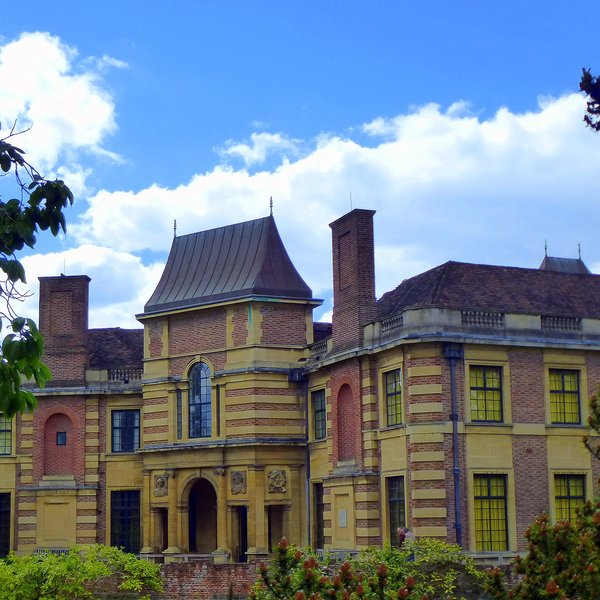
Eltham Palace
Is Eltham Palace one of England’s most haunted places?
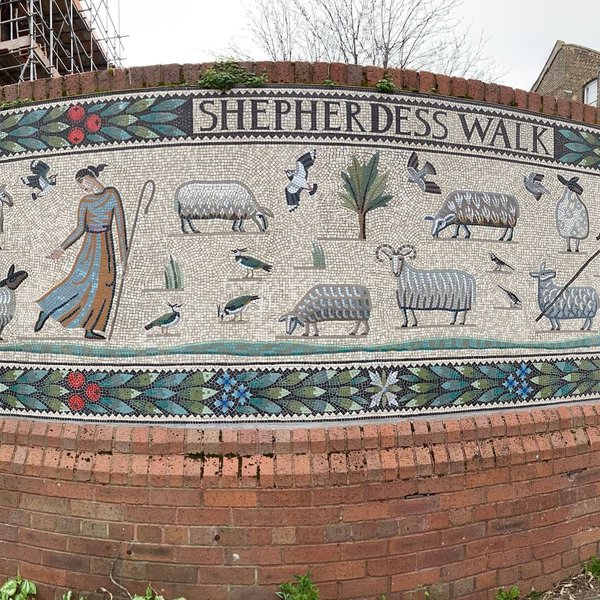
Shepherdess Walk
More than just a road, park and mural name in Hackney, London, Shepherdess Walk is the place to go to see where medieva…
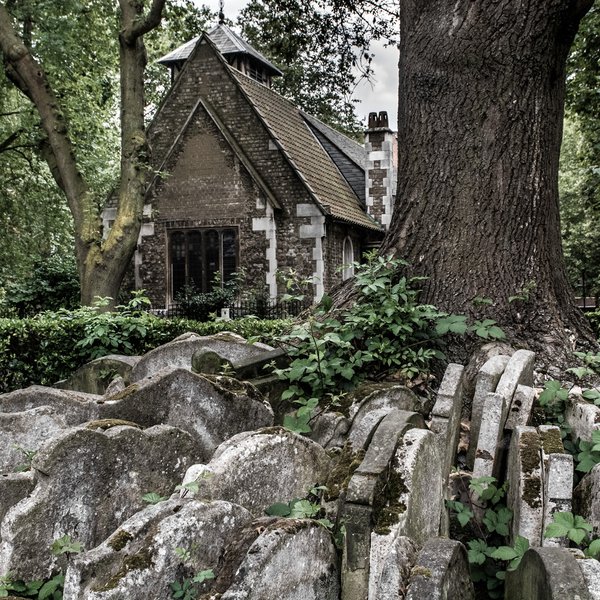
The Hardy Tree
Thomas Hardy, author of Far From The Madding Crowd and architect of one of London's strangest landmarks: The Hardy Tree.
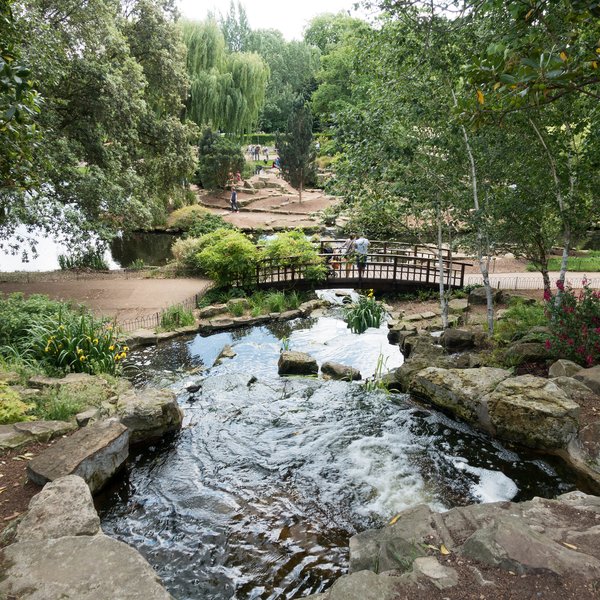
Queen Mary's Rose Garden
A tranquil garden containing London’s biggest collection of roses, Queen Mary’s Rose Garden is a peaceful place of beau…
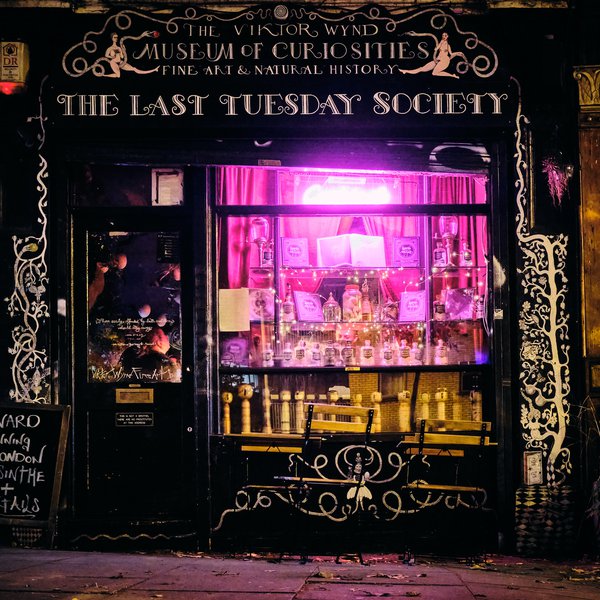
Viktor Wynd Museum
The Viktor Wynd Museum: where else can you find old master etchings alongside celebrity faeces; Happy Meal toys next to…
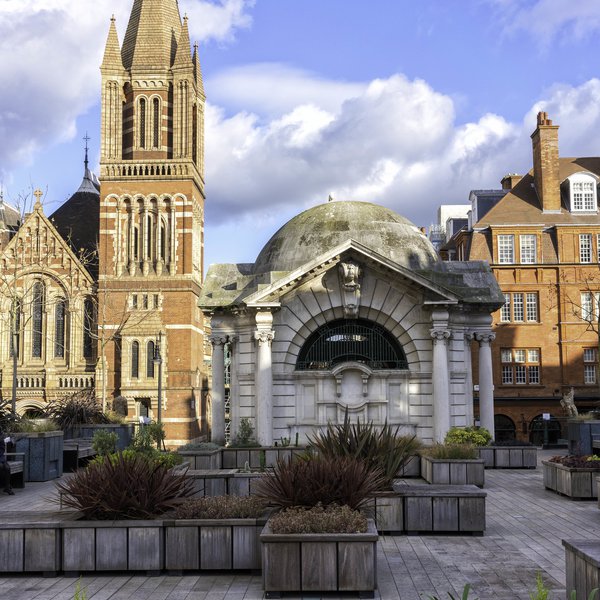
Brown Hart Gardens
Idle, disorderly and verminous persons beware: enter Brown Hart Gardens at your risk. And don't even think about practi…

Goodwin's Court
A Georgian alley thought to be one of the main inspirations of Harry Potter's Diagon Alley, Goodwin's Court is the perf…
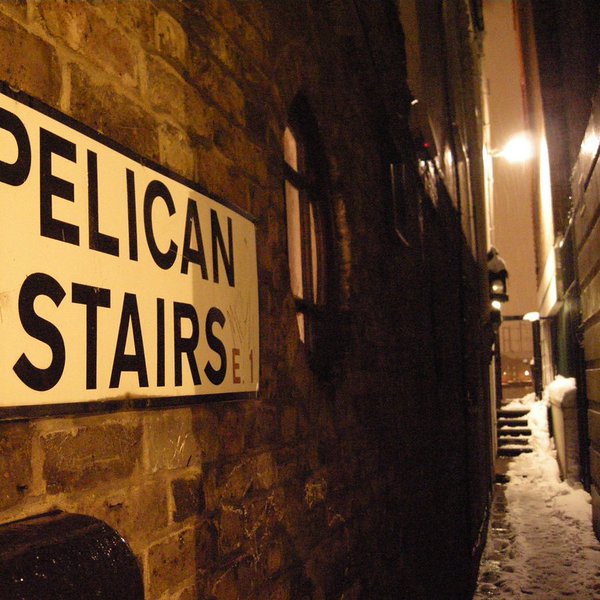
Pelican Stairs: A Hidden London Beach
Pelican Stairs is an alleyway in East London that leads to a hidden London beach. It runs alongside a historic pub, the…
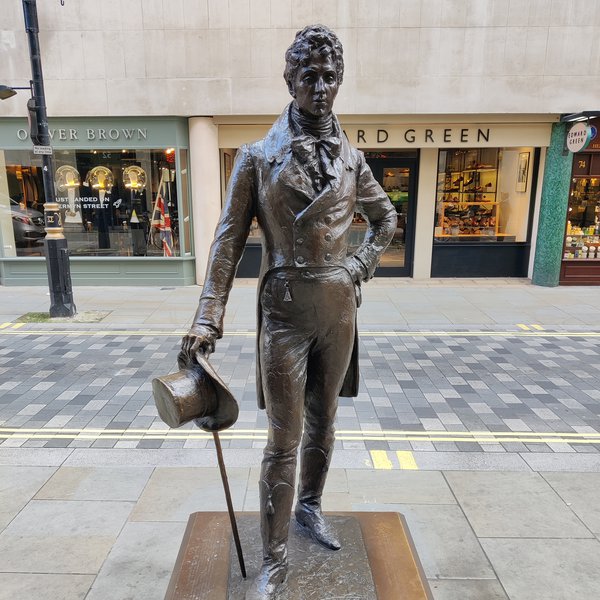
Beau Brummell Statue
The definition of a dandy, an influencer before influencers were even a thing, the laziest Officer that the Tenth Royal…

How to Visit the Great Fire of London Monument, London
By: Author Sophie Nadeau
Posted on Last updated: 23rd November 2021
Categories London , Secret History
Last Updated on 23rd November 2021 by Sophie Nadeau
The Great Fire of London didn’t start in Pudding Lane and more people died during the Great fire than as a result of the monument. These are just two of the factoids that are falsely taught in school…
So, if you’re looking for something to do on a Sunday afternoon in London on a budget , I feel you! Sometimes the Big Smoke is just so prohibitively expensive! Especially as a student.
Well, this Sunday, as I went off in search of a place to learn a little culture , I stumbled on the Great Fire of London Monument. Situated in the very heart of London, it provides both a great view over London for under a fiver and yet is a tragic reminder of London’s past.

The monument was built to both commemorate the fire and celebrate the rebuilding of London. The chief architects were Christopher Wren ( also architect of St Paul’s Cathedral ) and Robert Hooke ( also architect of Montagu house ). If you don’t know much London history, then the Great Fire of London took place in 1666.
It started a baker’s house on Pudding Lane, quickly spiralling out of control. A little known fact is that Pudding Lane isn’t named for sweet desserts but because ‘pudding’ is a medieval word for offal (the entrails of a butchered animal).
This year marks the 350th anniversary since the event… All the way back in 1666, h aving started on Pudding Lane, the fire quickly swept through the poorly built straw and wooden buildings of London, destroying thousands of homes, businesses and livelihoods in the process.
The destruction was such that new laws were soon passed during the rebuilding of London forbid the future use of straw and wood in new buildings. This is why, when you wander through London today, 99.9% of the structures are made of stone.

Pudding Lane wasn’t the start point of the fire
More than 6 people died from the fire, tips for visiting the monument to the great fire of london , controversy and theories.
It’s widely thought that the fire started on Pudding Lane (I even learned this in school!). However, new research suggests that this wasn’t at all the case. In fact, historians have even decided on the exact spot that they think the fire started! And guess what: it wasn’t a bakery!
When you get to the public viewing gallery (over 160 feet up), there’s a massive wire net at the top to prevent people from falling (although this wasn’t put up until at least a century after the Monument was constructed).
This means that officially, the Monument has killed more people than the Great Fire of London. Officially, 6 people died in the fire and 8 died from the monument (6 committed suicide and 2 more fell).
However, recent research has suggested that the Great Fire of London actually killed more people than previously suggested. This is because many died weeks after the event due to exposure and poor sanitary conditions. Tragically, it’s suggested that as many as thousands of people actually died in the fire.

Built between 1671 and 1777, the monument stands at 202 feet tall. If you were to lie down the column, it would reach the exact point where the fire started. Today, you can climb the 311 steps of the tower for under a fiver ( it’s open every day ). From the top, you can see the majority of London; the London Eye, the Shard , Tower Bridge are all visible from the top.
Funnily enough, the nearest metro station is Monument. From the station, the walk is about 2 minutes and you see the Great Fire of London Monument as soon as you step out of the tube station!
The queue to actually visit was only about ten minutes long ( on a Sunday afternoon ) so it’s never really busy. The Great Fire of London monument is open every day but times vary depending on the time of year, day etc.
If you’re afraid of heights or claustrophobic, then it’s pretty narrow both going up the spiral staircase and at the top so I wouldn’t recommend a visit…
Fancy seeing more? Here’s what the visit is like ( YouTube video ):

Sources: The Monument , Smithsonian , Daily Mail , Museum of London
This site uses Akismet to reduce spam. Learn how your comment data is processed .
7 Offbeat London Destinations You Won’t Want to Miss!
Wednesday 26th of July 2017
[…] to the Sky Garden usually needs to be booked a couple of weeks in advance, a visit to the nearby Great Fire of London Monument usually consists of little more than a half hour […]
Wednesday 16th of November 2016
Interesting post - I can't imagine it was only six people who died when so much of the city was ruined! The Museum of London is also a good place to go to learn a lot of about the Great Fire, they have an exhibit right now on it.
Tanja (the Red phone box travels)
Thursday 22nd of September 2016
I visited it too! it offers great views of London for a very good price!:)
Wednesday 21st of September 2016
That's really cool. I've never heard of this monument and I loved to know a little bit about the Great Fire of London. Amazing views up there!

Great Fire of London and Monument Trail
Walk the length of the fire that changed the face of london forever with visits to famous landmarks along the way.

London has changed a lot over the decades and centuries. But one of its quickest transformations happened in 1666 when a small fire started at a bakery in Pudding Lane near to London Bridge. Four days later it had destroyed most of medieval London including the old St Paul’s Cathedral.
A permanent reminder of the fire was erected soon after the fire was put out called The Monument. It stands today at the site of the first church to be destroyed by the fire and now at the junction of Fish Hill Street and Monument Street. Designed by Christopher Wren, it’s height of 61 metres marks the exact distance from the start of the fire.

School project
Recently my seven-year-old daughter came home from school and told us she was learning about the Great fire of London as many primary schools do around the country. Living only a 20-minute train ride away from central London we decided to jump on a train to visit the site where the Great fire of London started. And having chosen a particularly windy day, we would have to be brave to climb the 311 steps if we wanted to get to the viewing platform at the top of The Monument.

The nearest main line station to The Monument was Cannon Street and this would just leave a 5-minute walk east along the main road towards Pudding Lane and The Monument. It’s not as simple as just looking up to find the tall, slender column, nowadays it is entirely hidden by the huge city skyscrapers that surrounded it. In fact, your first view of The Monument comes when you turn right into Fish Street Hill off Eastcheap. If you’re heading into London into a different station, then use the underground and aim for (as you would expect) Monument station on the District and Circle Line.

London has changed
Before our trip we had a done a bit of research and looked at how much devastation the Great fire of London had caused. It was contained in the area that we now call the City, largely due to the Roman walls which surround the medieval city. Compared to today’s vast capital this part of London was relatively small. The distance between Pudding Lane and where the fire was finally extinguished, Giltspur Street in the area called Smithfield, was only just over a kilometre. This information was key to persuading my daughter to walk from the fire started to where it finished, the promise of cake and a hot chocolate stop along the way would also help.

The actual start of the fire is marked by this small bronze plaque which sits camouflaged amongst the cobbles in the middle of the junction of Pudding Lane and Monument Street. BE CAREFUL TRYING TO FIND THIS ONE!


Following the map
Armed with our A-Z London Map & Walks map and having decided on the best route to take, we headed away from The Monument and back towards Cannon Street station. Just after passing the station on the left the next historical icon appeared in front of us, St Paul’s Cathedral. We turned right at the far western corner of this impressive and popular building and past the iconic west entrance with its vast steps. The new St Paul’s Cathedral stands on the same site as the original cathedral built by William the Conqueror before it was consumed by the Great Fire of London. The large domed roof structure designed by Sir Christopher Wren of today’s building is one of London’s most famous landmarks and is a huge tourist attraction as well as being the home to the Bishop of London.

All this historical information was wasted on my daughter as she was much more interested in the wedding that was going on inside the cathedral coupled with the fact that there was also a coffee shop inside selling cake! But anyway, this was a perfect half way stop to refuel before the second part of the walk.

A very different part of London
Just north of the Cathedral is Paternoster Square which we entered through the Temple Bar Gates. Once inside we had a sense of Deja Vu hit as we were met by what seemed to be a slightly smaller version of The Monument. This structure wasn’t a replica, but it did look strikingly similar and it too was dwarfed by the buildings that surrounded it, but this time it was London’s Stock Exchange that dominated the skyline.
This part of London was eerily quiet for a Saturday afternoon but come Monday morning would be bustling again.
We aimed for the narrow alley to the left of the Stock Exchange before turning left onto Newgate Street. After 180 metres we turned right into Giltspur Street where, at the junction with Cock Lane and after a little searching, we finally found what we were looking for.

Reaching the end
The Golden Boy of Pye Corner in Smithfield is a small golden statue of a boy set into a wall and is much less grand than it’s counterpart at the start of the trail at Pudding Lane. It used to be part of a London pub before it was pulled down and now marks the spot where the Great Fire of London was finally stopped.
Great Fire of London and Monument trail route map

We used a London Map and Walks map to help us work out our route and to find all the historic places along the way.

Other Articles

The A-Z History of London
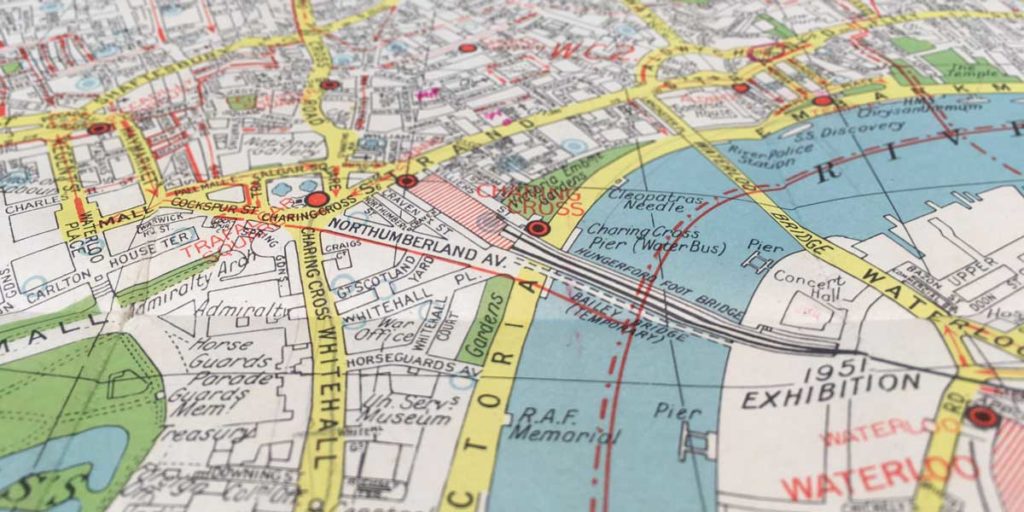
Revisiting an old map of London

Things to do in London
Cookie policy, privacy overview.
- Accessibility help
Visit The Monument
A permanent reminder of the Great Fire of 1666, the Monument commemorates one of the most significant events in London’s history.
Welcome to The Monument
The official website for The Monument, one of the City's most-loved attractions, which offers panoramic views over London.
The 202ft column, designed by Sir Christopher Wren and Dr Robert Hooke, was built to commemorate the Great Fire of 1666 and stands on the piazza between Fish Street Hill and Monument Street.
Discover The Monument's history
Climb the iconic 311 steps to the top of The Monument to enjoy panoramic views across London.
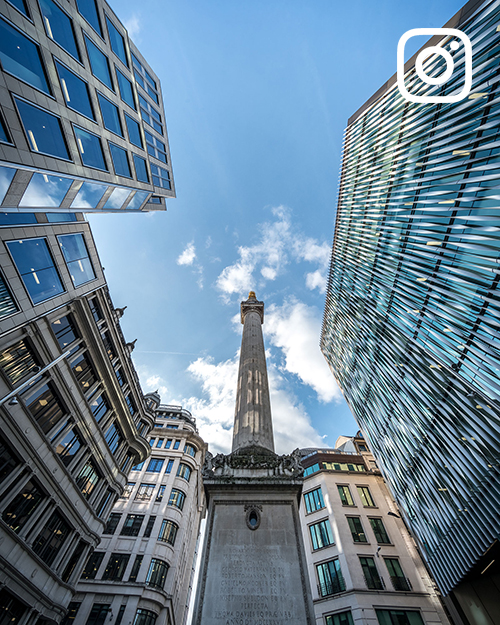

Great Fire Of London Walking Tour With Kids
The Great Fire of London was a monumental event in London’s history. The blaze in 1666 destroyed thousands of homes and left St Paul’s Cathedral a smouldering ruin. Rebuilding the city gave rise to some of the best-known architecture to be seen in London today. Its importance means the Great Fire of London is a topic studied in many UK schools, particularly in year 2 (KS1).
After questions from my daughter, querying: ‘where is the great fire of London’ and ‘can you visit the great fire of London?’, we decided to retrace its pathway. We took a family trip to London to see the Great Fire of London locations on a self-guided walk. Read on for details of our Great Fire of London free family walking tour, information about the Great fire with facts for kids and climbing Monument with children.
Where did the Fire of London begin?
The Great Fire of London started in at a bakery in Pudding Lane, an unassuming street in the heart of the City of London. The King’s baker, Thomas Farrier, lived and worked at the Pudding Lane bakery.
To get to Pudding Lane, go to Monument station on the circle and district lines.
It’s unclear exactly how the fire started. Farrier denied leaving this fire alight before going to bed. The blaze spread quickly amongst the 17th-century flammable timber housing and straw roofs. Recovering from a long drought, the houses caught fire quickly and were packed together so tightly the flames easily jumped from street to street fanned by a strong east wind.
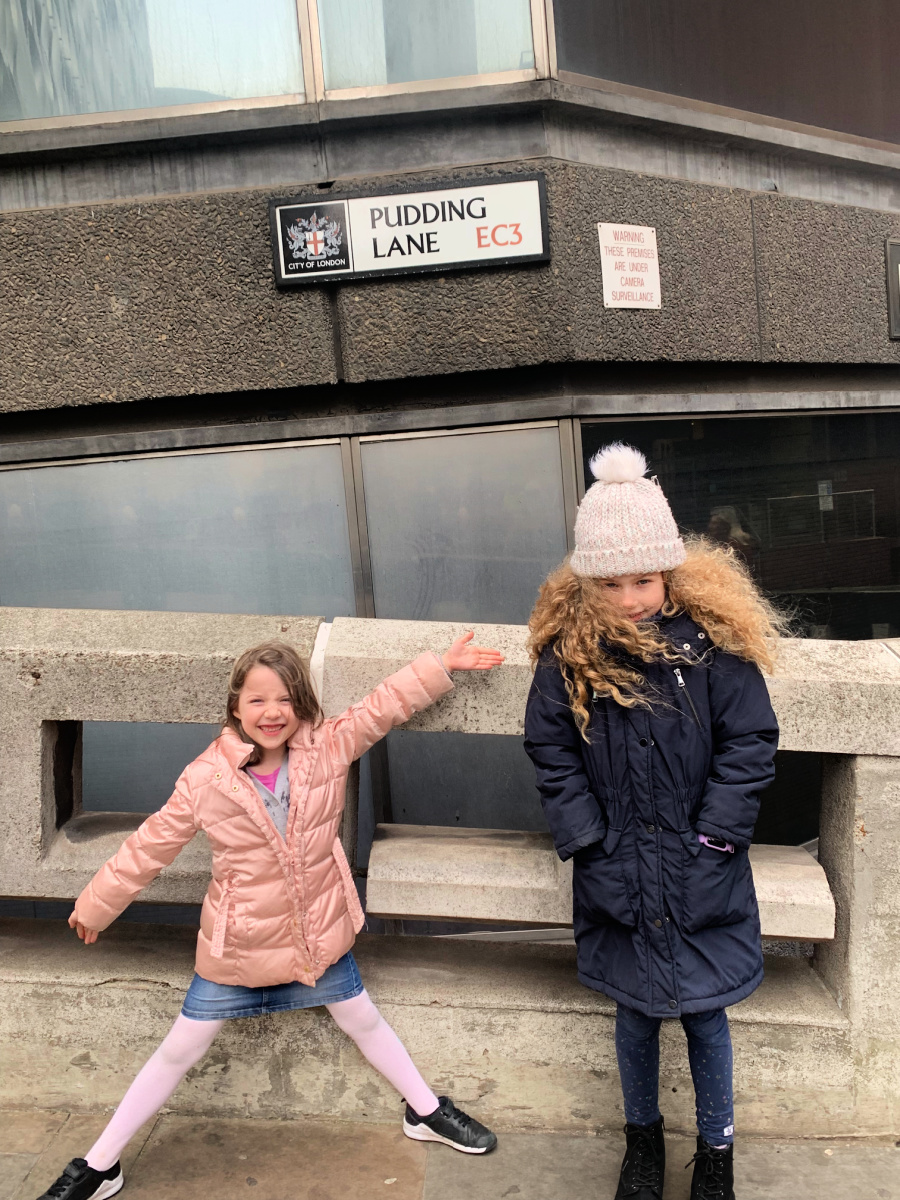
How long did the Fire of London last?
The Great Fire of London lasted for four days from 2 – 5 September in 1666, destroying 13,000 houses, 87 churches and leaving almost 100,000 people homeless. It caused significant damage to St Paul’s Cathedral which would later be rebuilt by Sir Christopher Wren.
After a couple of minutes wondering where Farrier’s infamous shop stood, we spotted a plaque on the side of a building marking where the bakery resided.
One of my daughter’s top facts about the Fire of London which she quizzed us on was: ‘How many people died in the fire of London’? Officially, only six perished. Of course, this has since been called into question. Due to the severity and heat of the fire, it is likely many remains where not discovered and those from poorer backgrounds were not counted.
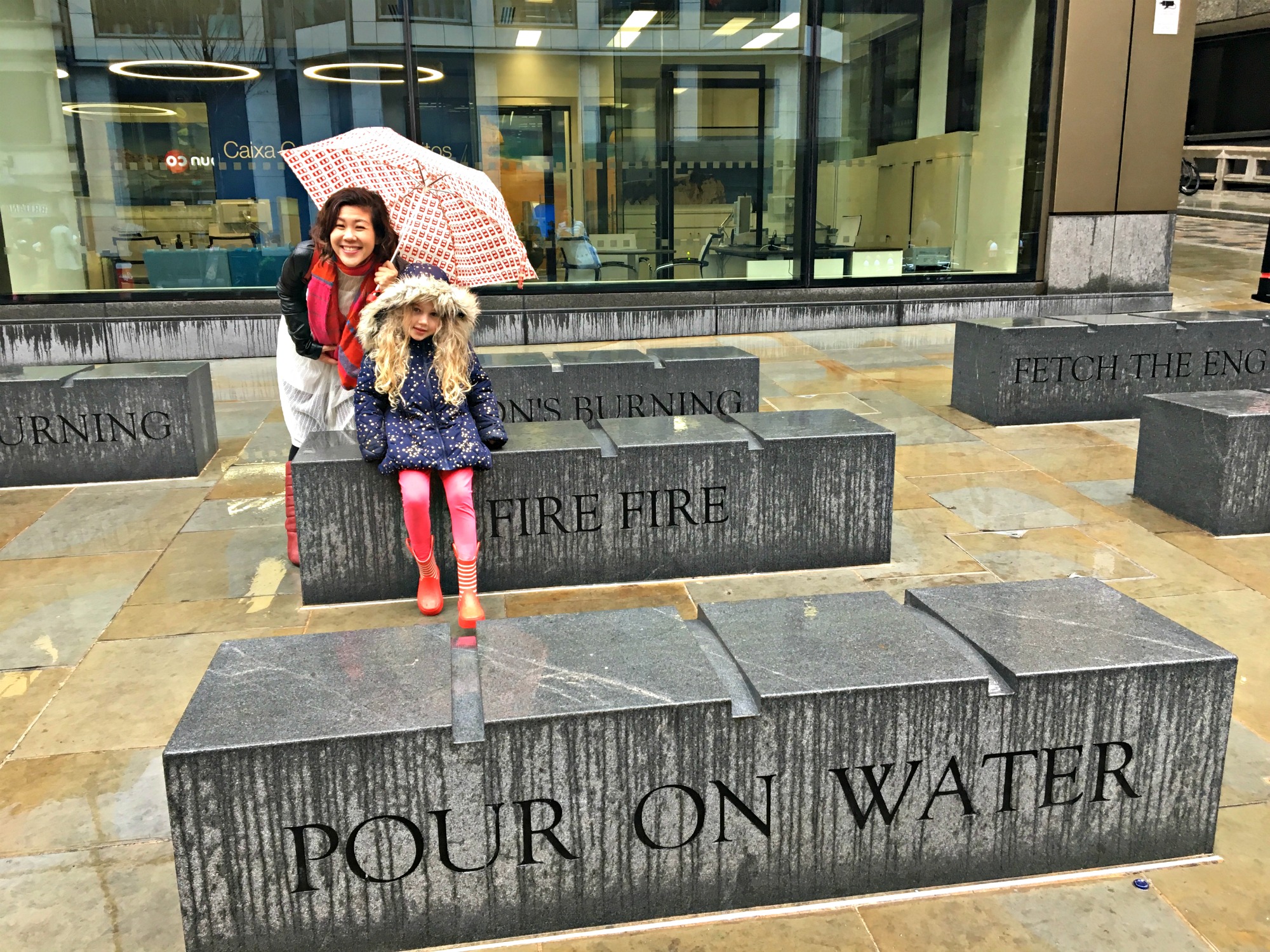
Fire, Fire sculpture at Monument
Across the narrow road from Pudding Lane are some concrete blocks with the words from the famous nursery rhyme, London’s Burning.
“London’s Burning, London’s Burning, Fetch the engines, fetch the engines, Fire, fire, fire, fire, Pour on water, pour on water.”
As well as bringing back childhood memories of the rhyme (usually sung in a round), it also serves as a good place for photos and somewhere to rest your legs, especially if you’ve just climbed up Monument!
Visiting Monument, London
You can’t miss Monument, the soaring structure designed by Sir Christopher Wren and Dr Robert Hooke. A memorial to the Great Fire of London, it stands next to Monument tube station. At 202 feet high, it marks the distance away from the scene of the fire in Pudding Lane (202 ft away).
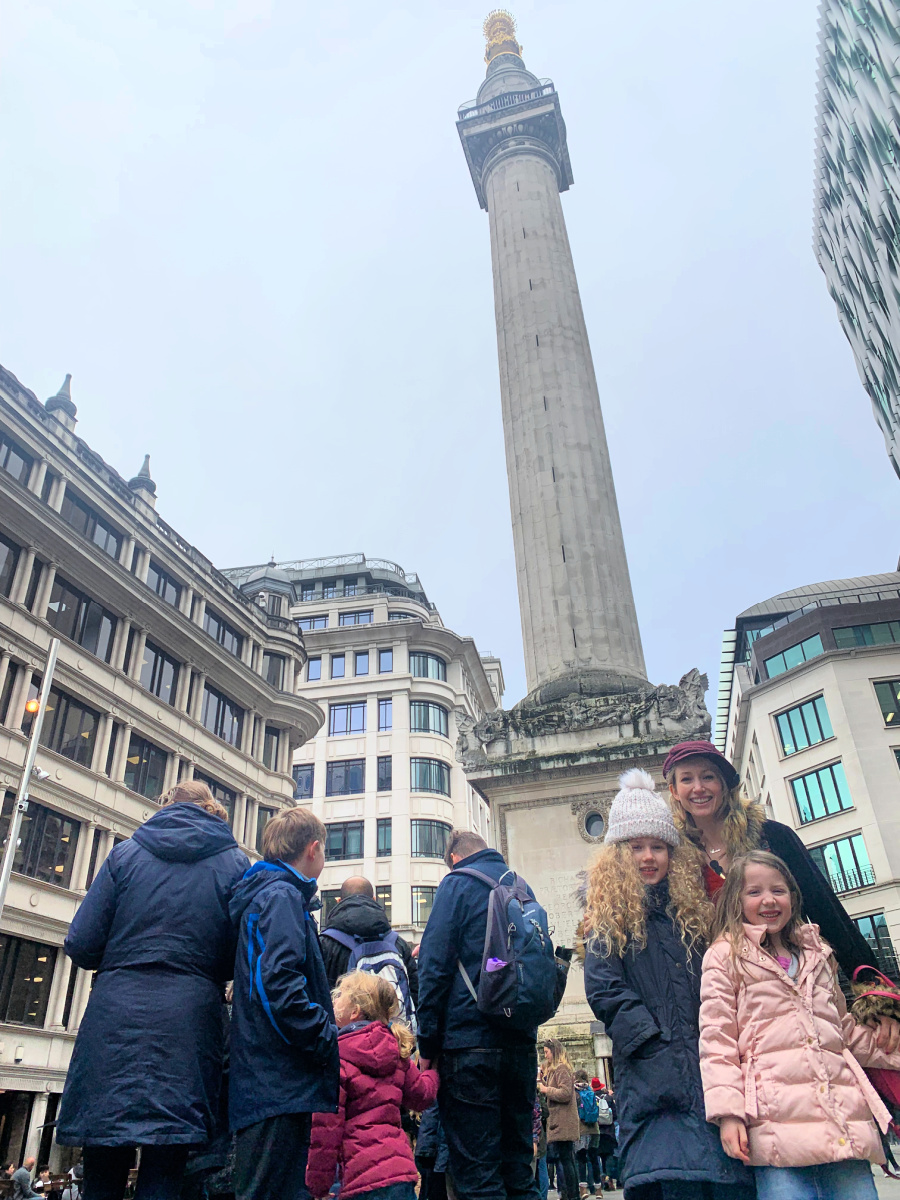
The column has 311 steps to the top. There was no question, we had to climb! Going during the half term holiday, it was busier than normal mid week but they limit numbers inside to 33 people at a time.
London Monument Climb
The staircase inside Monument is narrow in places and you have to make way for visitors coming down but my six year old raced on ahead and barely broke a sweat – or complained. Soon we had climbed to the top of London’s Monument.

You are treated to 360 degree views of London from the top of Monument. Even in the cloud and rain, London is a wonder to behold. You can see all the landmarks of London including modern buildings including The Shard and Gherkin.
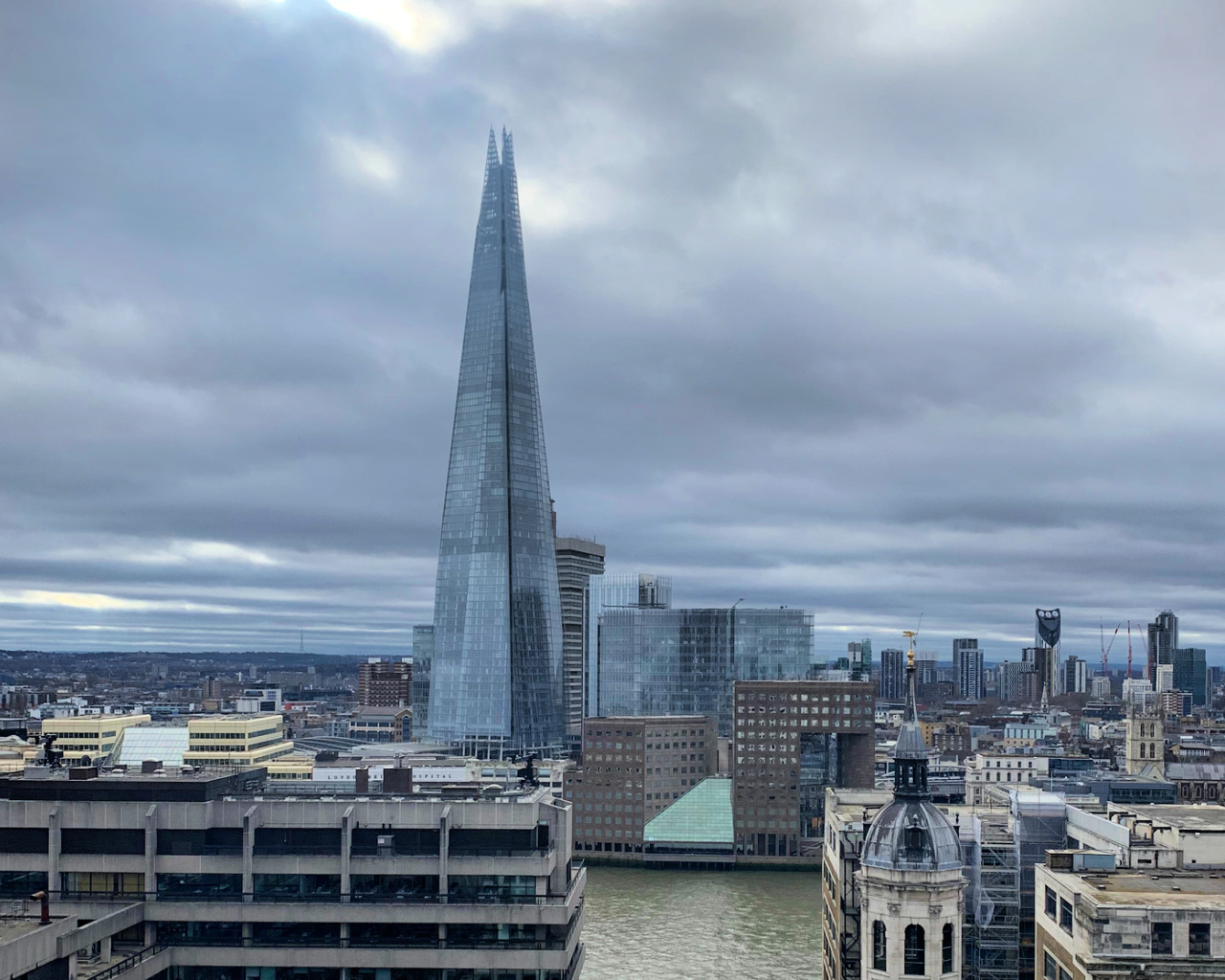
Looking south-east, you can see the Thames and Tower Bridge. Monument is a top place for London views, if you are prepared to climb up the steps.
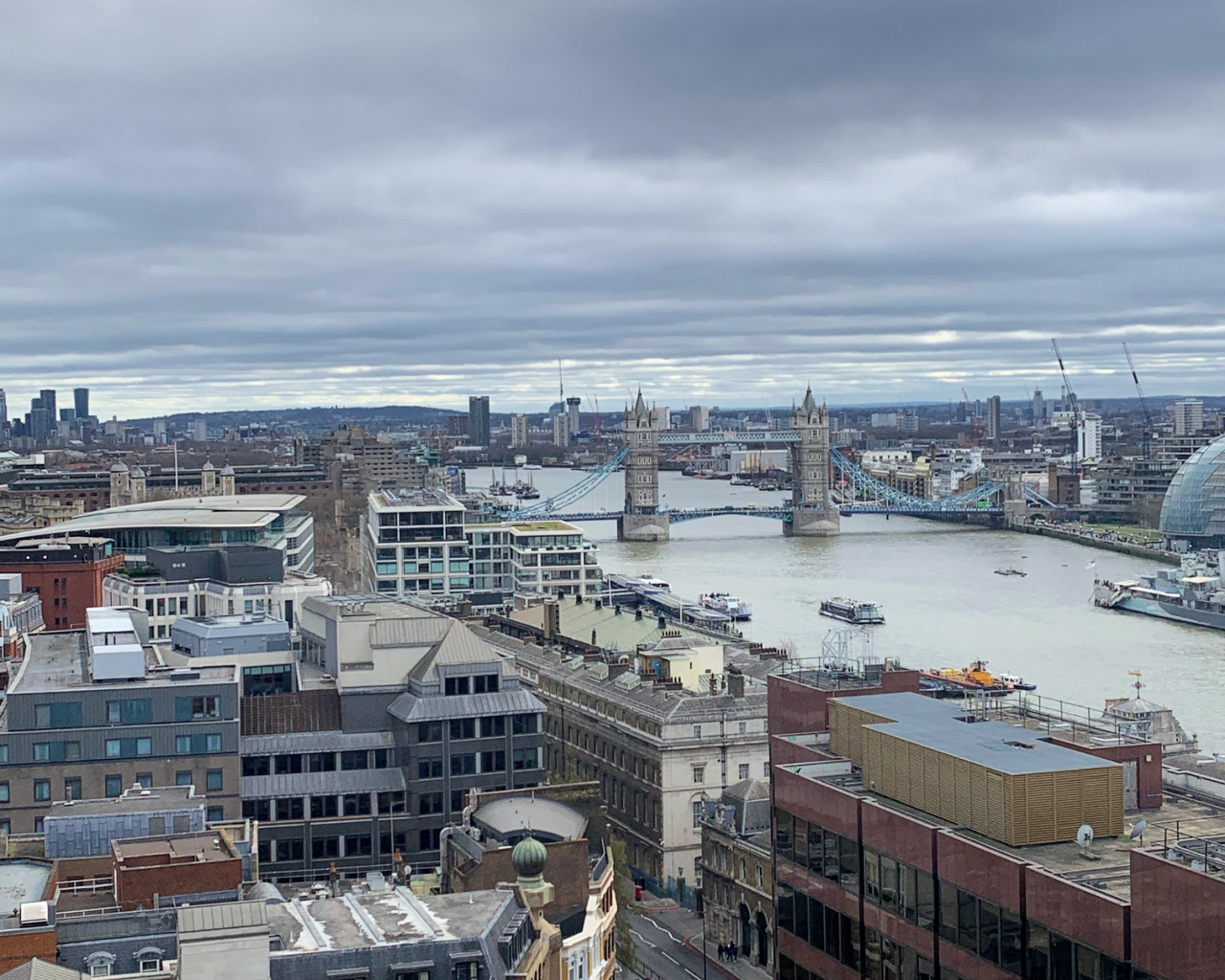
St Paul’s Cathedral is visible at the top of The Monument. Rebuilt after the fire, the Sir Christopher Wren design is one of the most famous buildings in London. Glimpsing it standing so far away from Monument and the scene of fire, it put the Great Fire of London into perspective for my daughter. The fire continued much further but didn’t make it across the Thames to London’s South Bank.
To climb Monument , it costs £4.50 for adults and £2.30 for children. I was glad we weren’t with younger children. Carrying a toddler while climbing Monument’s 311 stairs would have been challenging. When you have descended, you are rewarded for your efforts with a certificate!
If climbing up sounds like too much hard work or you have younger children, check out the bas relief at the bottom of Monument which shows the destruction of the city. It features Charles II and his brother James (later King James).

On the other sides are inscriptions in Latin describing the actions taken by King Charles II who came out onto the street with a bucket to help. It also details how it started and stopped and the damage caused. Words which wrongly blamed Catholics for the fire were chiselled out in 1830.
Once finished, it might be time to grab a drink or some food. There are plenty of place nearby to visit. We went to somewhere close to Leadenhall Market.
To get to Leadenhall Market, head up Pudding Lane turn right then go up Philpot Lane. Keep going north onto Lime Street then go left onto Leadenhall Market.
Leadenhall Market
One of the oldest markets in London this iconic space is now best known for its Harry Potter fame. Leadenhall Market made up Diagon Ally in Harry Potter and the Philosopher’s Stone and is where Harry and Hagrid enter the Leaky Cauldron pub. If you have Harry Potter fans with you then this is a must-see place to include on your Great Fire of London tour.
In terms of the Great Fire, the blaze didn’t go any further North East than Leadenhall Market. Part of the market was destroyed but its stone structure saved other areas.
On the third day of the fire, flames reached Guildhall, home of the City of the London Corporation. Completed in 1430, as it was made of stone, the fire did not destroy it. Guildhall is one of the few medieval buildings in the City to survive following the fire.
An incredible building, Guildhall is worth going to see and if there are no events on, venture inside to view its stunning Great Hall and art gallery which has paintings of the Great Fire. Admission is free.
Find your way to Threadneedle Street, past bank station and onto Poultry then down King Street. Guildhall is on Gresham Street.
St Paul’s Cathedral
To get to St Paul’s Cathedral, make your way back onto Cheapside, passing St Mary-le-Bow on the way, one of many churches rebuild by Sir Christopher Wren following the fire. It’s famous due to its bells. If you are born within earshot you are said to be a Cockney.
From there, you can’t miss seeing the iconic dome of St Paul’s Cathedral. Continue along Cheapside then head through the churchyard to the entrance. If you are hungry, there are plenty of eateries on Cheapside and in the shopping centre, One New Change, to stop and refuel.
Visiting St Paul’s Cathedral
To enter St Paul’s when there isn’t a service on, you have to buy a ticket, which lasts for a year. I had one from when I visited previously to climb to the top of St Paul’s Cathedral .
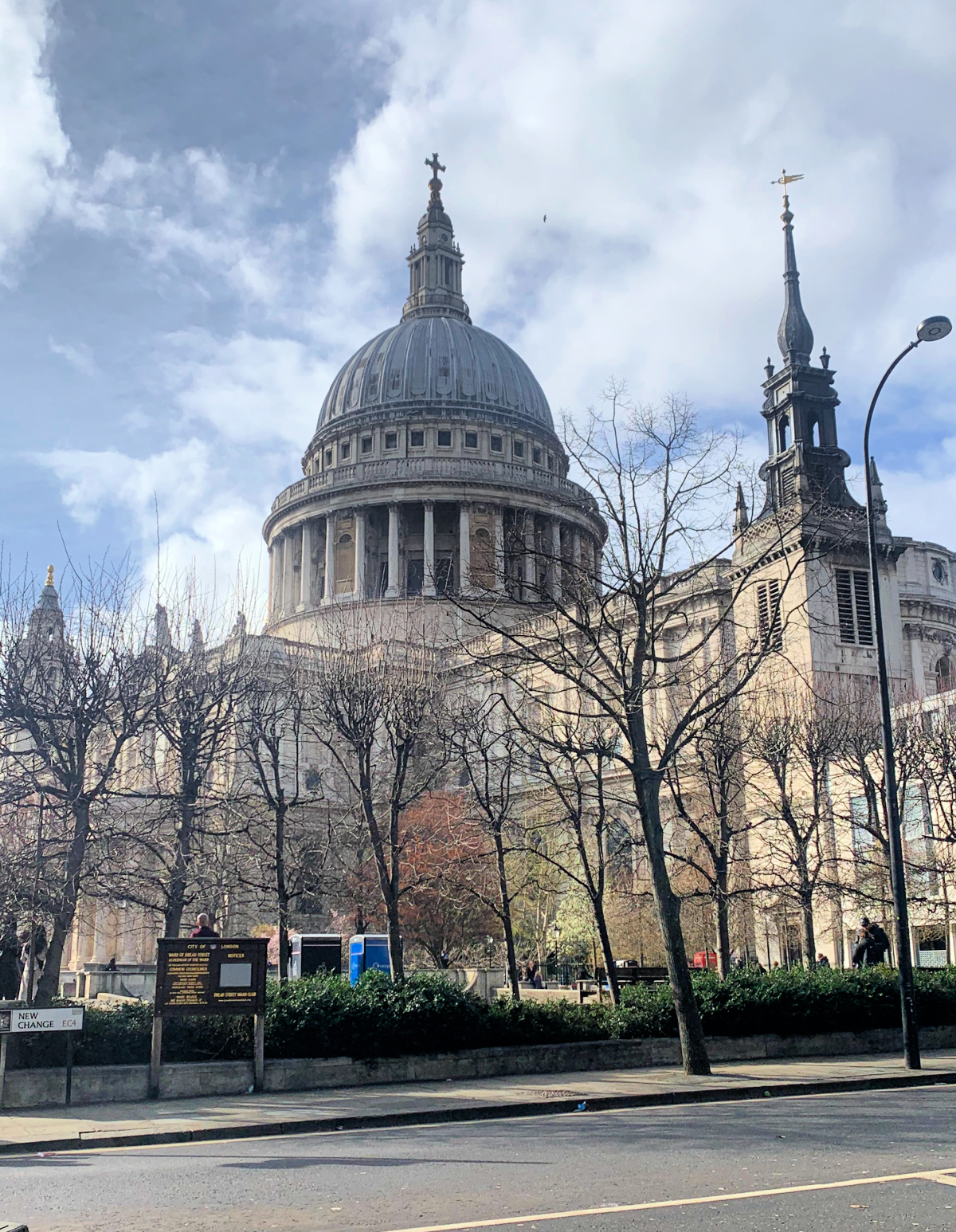
Plans were already underway before the fire to restore and rebuild St Paul’s with Sir Christopher Wren at the helm. The scaffolding in place when the fire broke out helped spread the flames and two days after the fire started, the blaze engulfed the Medieval cathedral.
Many had sought refuge in St Paul’s with one person perishing inside. The Cathedral’s wooden roof, scaffolding and huge library containing thousands of books in the crypt meant the building was destroyed, burning for a week.
To visit St Paul’s Cathedral , it’s £23 for a ticket on the door which lasts for a year (it’s £20.50 online). Under 5s go free. It’s £10 (£9) for children aged 6-17. Family tickets are also available.
The River Thames
If you still have energy, head to the River Thames. Go down Godliman Street, turn left then right and you’ll see the Millennium Bridge. In 1666, the only bridge across the River Thames was London Bridge. It was packed with houses at the time so wasn’t a good escape route from the fire. When the fire broke out, it was chaotic along the river with warehouses burning and merchants throwing their goods into the river. Fortunately, the river managed to halt the fire and the Great Fire of London did not spread to the South Bank.
The Great Fire of London Facts and Legacy
The Great Fire of London helped to alter the skyline of London and bring change to the city. Home insurance was created and buildings had to be faced in brick following the fire. There were also tighter building controls and houses were no longer built so close together.
It wasn’t until 1865 that the London fire brigade was established but with the invention of home insurance, companies set up their own fire brigades.
Many were left homeless after the fire, sleeping in tents in fields around the city. Disease spread and due to a cold winter many died. But the fire did help obliterate the Black Death by killing rats carrying the deadly disease.
It’s hard to imagine London without the iconic dome of Sir Christopher Wren’s St Paul’s Cathedral. As the king’s surveyor, Wren helped to design 52 churches in the City of London as well as Monument.
KS1 Great Fire of London
Our Great Fire of London walk ended at St Paul’s Cathedral and we hopped on the tube home. If you have a child in KS1 who is learning about the fire, you will no doubt have helped create a 17th-century house made of cardboard. Designed to be burnt (to illustrate how quickly the fire spread), ours returned home – intact – much to my surprise.
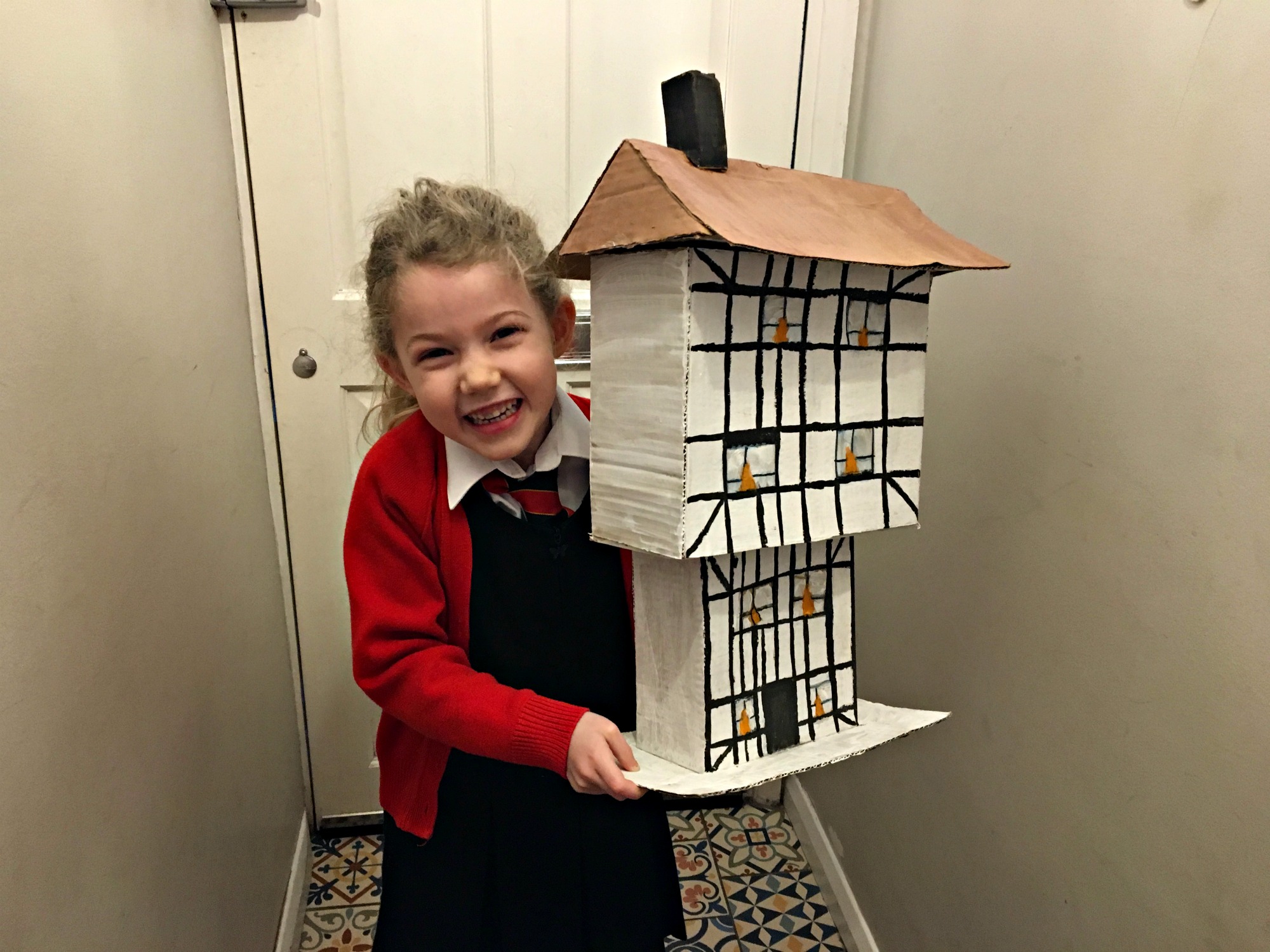
Retracing history in a Great Fire of London walk was a great day out and helped reinforce the significance of the event for my daughter. I’d recommend going to these key sights. If you can pick a brighter day, London will look even better from the top of Monument.
You may also enjoy reading
Journey through history at the Museum of London Climbing to the top of St Paul’s Cathedral Day out at the London Transport Museum
If you liked this article about the Great Fire of London walk, you can download it – along with other city guides – as an app at GPSmyCity .
Pin for later
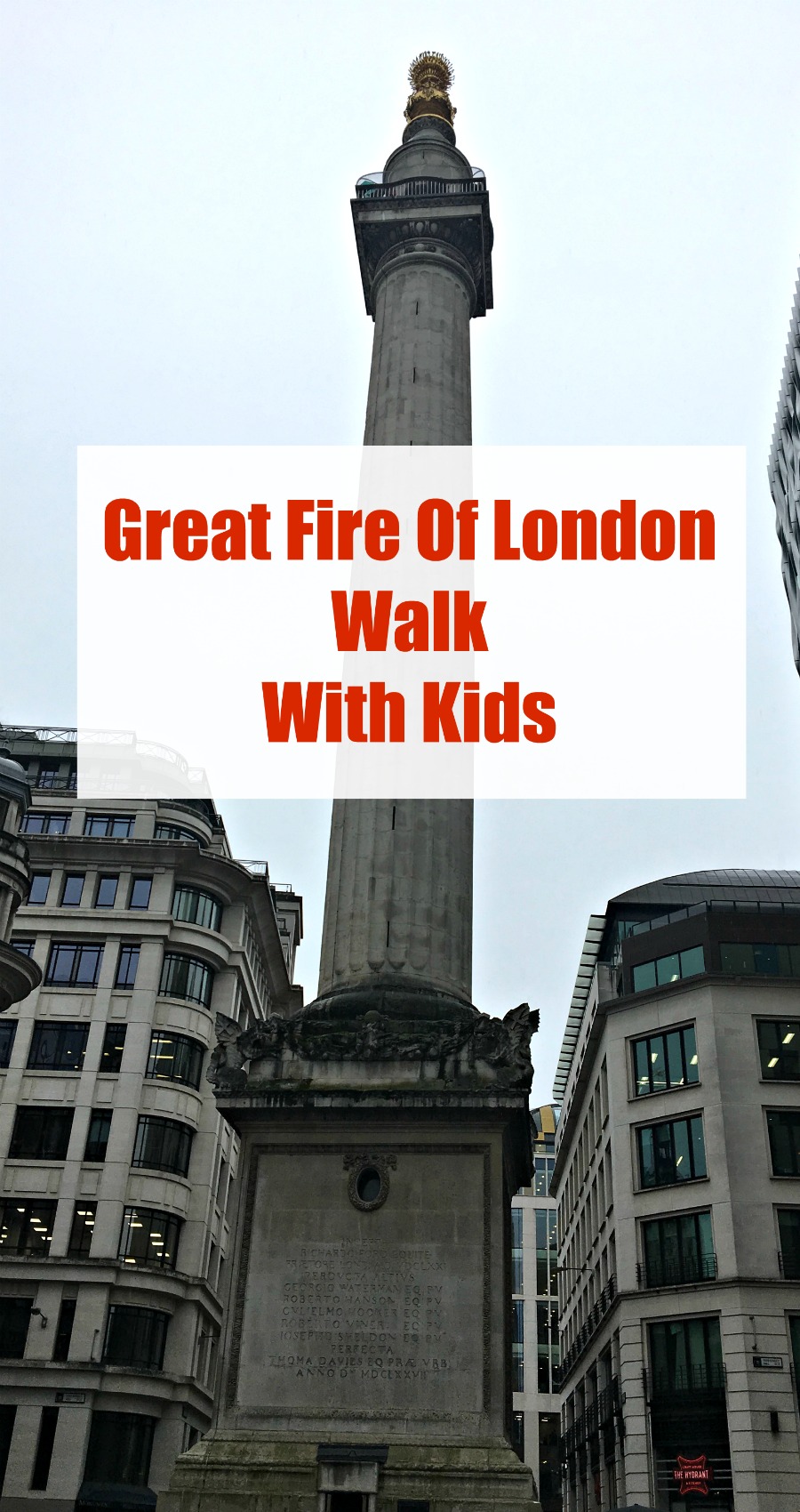
SUBSCRIBE TO OUR MAILING LIST
For the latest news, posts and competitions sent directly to your inbox - sign up below:
*You can view our privacy policy here
RELATED POSTS
I've always loved to travel so when my two daughters came along, I didn't stop. Travelling as a family can have its ups and downs but I love showing my children the world and helping others navigate travelling with children in tow.
Top Christmas Activities For Kids in London 2022
Alice in wonderland at kew gardens review.
Fantastic! Such a great thing to do. Enjoy!
Leave a Reply Cancel reply
Your email address will not be published.
Notify me of follow-up comments by email.
Notify me of new posts by email.

This site uses Akismet to reduce spam. Learn how your comment data is processed .

Is Christmas at Kew worth visiting?
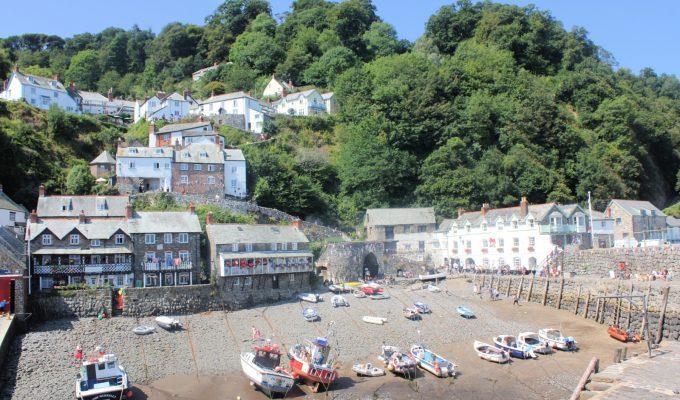
Visiting Clovelly With Kids: Is it the Prettiest Village in Devon?

Where to go in the UK for a summer holiday staycation

Coronavirus and travel: Why I am staying in the UK this summer
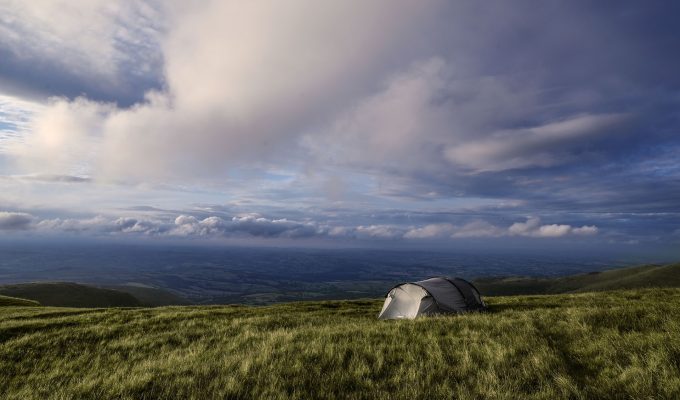
Post Lockdown Summer Travel Plans: Go Overseas Or Stay In UK?
Pin it on pinterest.

Plan Your Visit more itineraries
The kidrated great fire of london tour.

Loads of kids learn about the Great Fire of London at school. So why not make their history lessons come alive with a quick tour of the City of London where the fire happened in 1666! Here’s our handy guide…
Back in 2016, London marked the 350th anniversary of the Fire. Check out the Museum of London ‘s website and offline exhibitions for loads of family friendly activities and events.
Pudding Lane
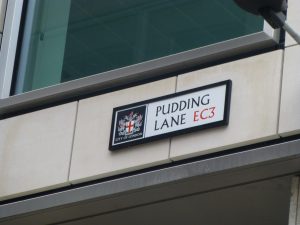
Start the day at the Pudding Lane sign which is modern now but still exciting for kids learning about the fire. You can even find a plaque on pudding lane saying this is where the fire started.
It’s small, quaint street widely known as the location of Thomas Farriner’s bakery where the Great Fire of London started in 1666. The fire that burnt down a whopping 80% of London’s medieval buildings.
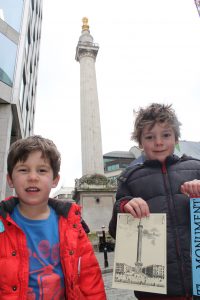
Jack & Oscar with their Monument Certificates
The Monument to The Great Fire of London is one of the City’s most popular attractions. You will find lots of information about the Fire and you can even climb to the top from where you can see great views of London. There are a lot of stairs, but kids can get a certificate at the end to prove they have climbed to the top.
The column is 62 metres tall and is the tallest free-standing stone column in the world. It is also 62 metres from the exact spot where the Great Fire of London started in Pudding Lane.
St Magnus the Martyr
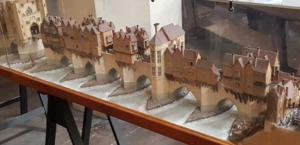
Model of Old London Bridge
Quickly pop into this Christopher Wren-designed church next to Monument where you can see a 17th-century fire truck and a model of Old London Bridge.
London Bridge
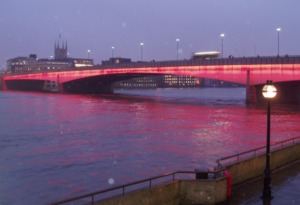
London Bridge at night
Then you can go see the London bridge that stands today. As Pudding Lane is right by the Thames, people escaped the fire on boats to South of the River. From London Bridge you will have a good view of the Thames.
Cannon Street
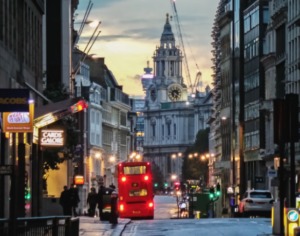
A view down Cannon Street
Walk down Cannon Street. The fire spread right down this road also leads to St Paul’s Cathedral.
Cannon Street traces the route of the ancient riverside track that ran alongside the Thames towards the Strand. Cannon Street is also the home of London Stone – a mystery of history. It’s a block of oolitic limestone on external display at 111 Cannon Street. It is an ancient relic of uncertain history. The present stone is merely a chunk and there is no record of how or when it came to be fragmented or what happened to the rest of it. Find out about the different theories surrounding the stone by taking a little gander online.
St Paul’s
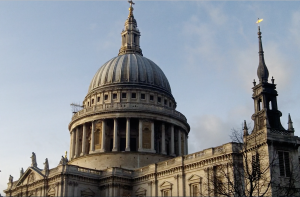
St Paul’s Cathedral
The fire burnt down the Medieval cathedral but Sir Christopher Wren built the new St Paul’s which still stands here today. You can’t take photos inside but there’s still a charred statue in there from the fire. If you aren’t feeling too tired from walking up Monument, you can walk up the stairs to the Golden Gallery where you can see more views of London. On your way up, don’t miss the Whispering Gallery.
Museum of London
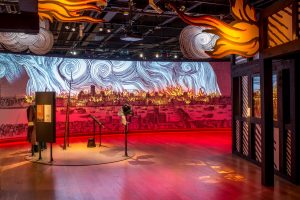
Fire! Fire! exhibition at the Museum of London
The Museum of London has loads of information about the Great Fire of London along with facts about London from its Roman origins to the present day. It’s only a short walk from St Paul’s.
And the the museum also has a raft of online activities, information and even a Minecraft game that kids of all ages will love.
If you get peckish at all during this tour, head to the beautiful Leadenhall Market where you will find a Pizza Express. Or hop across London Bridge to Borough Market .
2 comments on “ The KidRated Great Fire of London Tour ” | Add a comment
Hello, this is great thank you! We are going to do this on Saturday with our 5 year old. Can you give me a rough guide to how long it too from start to finish?
Hiya Anna – we’d allow half a day for this. Hope you enjoy it – send us a review.
Leave a Reply Cancel reply
Your email address will not be published. Required fields are marked *
Save my name, email, and website in this browser for the next time I comment.
FEATURED ATTRACTIONS
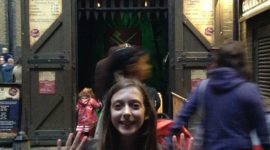
TOP THEATRE DEALS
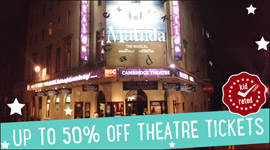
winning K-RATERS

All K-Raters get a certificate , and the chance to win great prizes.
KIDRATED BLOG
For all the latest K-Ratings, news, special offers and giveaways
Follow KidRated and the KidRated community!
Connect with the KidRated community!
Enter your email address to receive the latest update from KidRated

sign up to the KidRated newsletter
- Receive exclusive offers - Up to date news on attractions and events - Special prize giveaways
- Food & Drink
- Things To Do
- Beyond London
Crafty Shortcuts: These Secret Steps Of Pudding Lane Lead To A Thames Terrace

Did you know that Pudding Lane turns into a 'secret' aerial walkway? And it leads to a magnificent Thames view.
Generations of Londoners have stood before the Monument and thought "I'll climb these stairs for a view". But perhaps not this set of stairs...

The unremarkable flight rises just to the south-east of the giant column. Would you walk up them? They look like they might lead to corporate offices, or Somewhere You Should Not Be.
They're hidden behind a hedge, for pity's sake. Hence, they're generally ignored.
In fact, the steps are open to anyone, and they herald the most direct and rewarding route to the Thames. Ascend! You won't regret it.

Curiously, the highwalk seems to be classified as part of Pudding Lane, even though it's a couple of storeys up from road level. A street sign up here confirms the name, famous as the site where the Great Fire of London began in 1666.
The walkway leads to an information board and plaque, which explain the site's Roman history — revealed during excavations for the offices. We learn that, 2000 years ago, the river would have lapped right up to Pudding Lane, over 100 metres further north than the Thames we know today. The Romans built a substantial quay here, which was used to offload imports of wine and olive oil.
If you've got your eyes open, you'll note that the site's history goes back long before the Romans. The Portland stone walls here are speckled with fossils, the echoes of marine snails and bivalves that died 150 million years ago. Aptly, they lead us on to the river.

After spanning Lower Thames Street, the raised walkway leads out onto a wide rooftop space. Here, you can expect excellent views of St Magnus the Martyr church (above). This church is a fascinating place to visit in its own right. Old London Bridge passed right underneath its porch. Stones from the old bridge, along with putative Roman timbers can be seen in the churchyard, while a model of Old London Bridge lurks within.

Once you've finished ogling St Magnus, carry on along the walkway and you'll soon spill out onto a substantial roof terrace overlooking the Thames. The views here are excellent, with Tower Bridge to the left, the Shard straight ahead, and London Bridge to the right. We came to this balcony on 5 July 2012 to watch the laser-flourishing inauguration of Britain's tallest building.

Unless an event of similar magnitude is unfolding, you're unlikely to find many other people up on the balcony. It's one of those places that hides in plain sight, right above the busy Thames Path, yet almost never noticed. This despite a rather prominent sign down below:

So, there we have it. We've followed most direct route to the Thames from the Monument, taking in Jurassic seas, Roman boats, a Wren church and a little-known viewpoint. Definitely a short cut worth knowing.
Last Updated 12 April 2023
Continued below.
You May Also Like:
- Crafty Shortcuts: The Charing Cross Elevated Walkway

16 Spring Day Trips From London: April 2024

Things To Do In London Over Easter Weekend 2024

Easter 2024 Transport In London: Which Train And Tubes Are Running, And Which Stations Are Closed?

60 Of The Best Things To Do In London This Spring
Londonist in your inbox.
Get London news, inspiration, exclusive offers and more, emailed to you.
- I would also like to receive the Best of Londonist weekly roundup
Thank you, your preferences have been saved.
Follow londonist, report a problem.
Something wrong with this article? Let us know here.
Thank you, your feedback has been noted.

- The Concert
- Members Hub
- Getting Here
Accessibility
- Food & Drink
Oceanbird Lounge
The ABBA Arena is built around ABBA’s timeless music, offering you an experience like no other.
Food & Drink
Abba’s breath-taking arena delivers the perfect setting for abba voyage..
Located at Queen Elizabeth Olympic Park, London, the arena is purpose-built for ABBA’s never before-seen concert. The location offers easy access to transport links, local shops, plenty of food & drink options, along with a variety of seating and standing ticket choices and accessible entry.
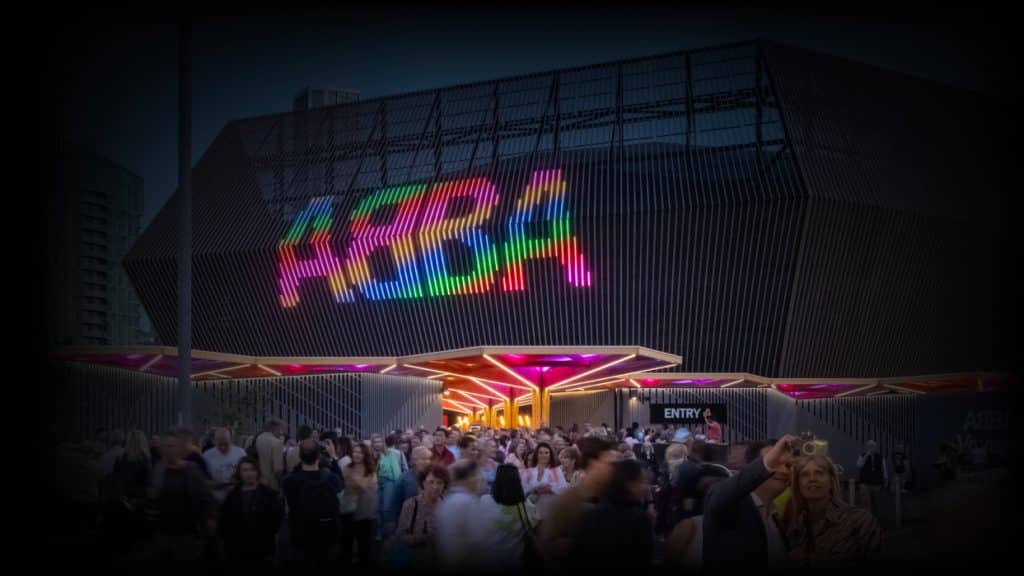
ABBA Arena, Pudding Mill Lane, London E15 2RU
The nearest public transport stations to the ABBA Arena are Pudding Mill Lane and Stratford, which are some of the best connected in London, with easy transport links to the rest of the city, local regions and Europe.
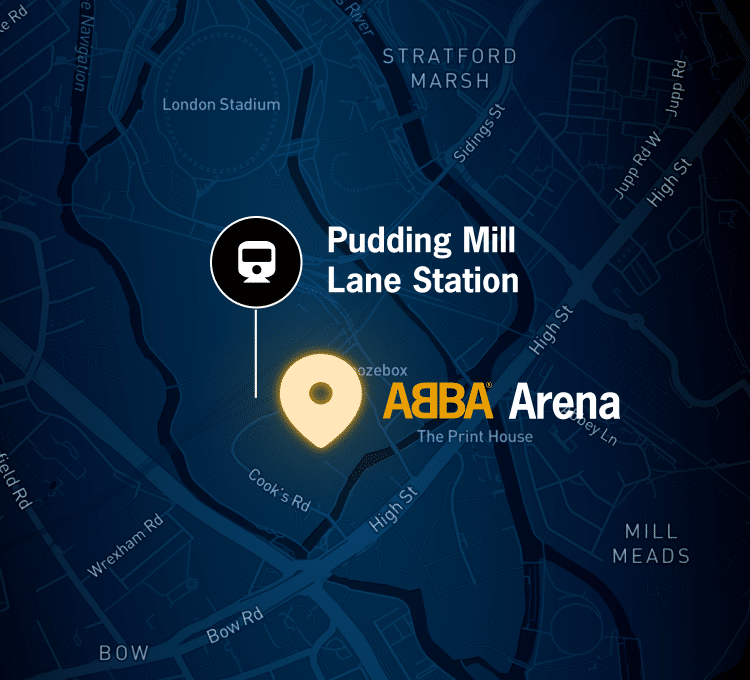
The closest station to the venue is Pudding Mill Lane on the DLR (Docklands Light Railway), and the ABBA Arena is immediately opposite the station.
The closest underground station is Stratford, located on the Central and Jubilee lines, and the closest National Rail station is Stratford International. The walk to the ABBA Arena from Stratford is around 25 minutes. Alternatively, you can change at Stratford station to get on the DLR (Docklands Light Rail) towards Canary Wharf from platform 4a and take the train one stop to Pudding Mill Lane.
By Bus & Coach
A coach transfer from Central London to the ABBA Arena is available by clicking here .
There are no parking spaces available for coaches to wait, but coaches can drop off and pick up on Pudding Mill Lane.
The easiest way to get to the ABBA Arena is by rail on public transport.
If you wish to cycle, there are 100 bicycle parking places located on either side of the arena gates. Bicycles may be left there are at owners’ risk and ABBA Voyage will not accept any responsibility for any damage, accidents or losses.
By Car & Taxi
The only parking available at the ABBA Arena is for blue badge holders, and these spaces must be booked in advance. We strongly encourage travel via public transport or bicycle as parking options at Stratford and Westfield are available but are not controlled by us.
If you would like to enquire about blue badge parking, please get in touch at [email protected]
If you wish to hail a black cab, there is an appointed black taxi rank on Barbers Road.
The ABBA Arena is located immediately opposite Pudding Mill Lane station on the DLR (Docklands Light Railway). However, you can also alight at Stratford station and enjoy the walk through Queen Elizabeth Olympic Park.
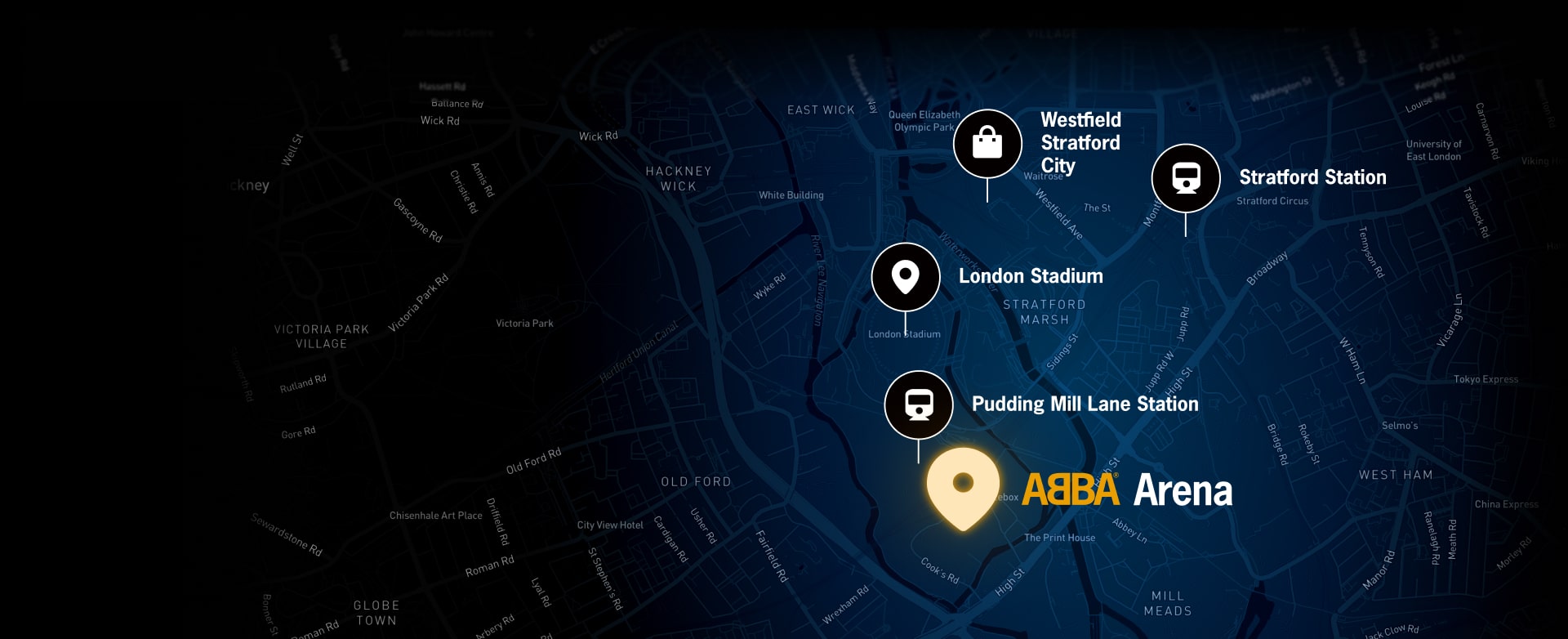
If you have any specific access needs, requirements or would like any further information, please contact us at [email protected] .
Blue Badge Parking
The ABBA Arena offers 10 parking spaces for blue badge holders. These are located on the arena site a short distance from the main entrance. Spaces must be booked in advance, so if you would like to enquire about booking one, please get in touch at [email protected]
British Sign Language Interpreted
For these performances we hold tickets in Booth A with the best view of the interpreter. Tickets can be purchased by emailing [email protected] .
Next BSL interpreted performance:
17th February 3pm – Sold Out 12th May 6pm – Sold Out 20th July 7:45pm – Sold Out 19th September 7:45pm – Sold Out 17th November 1pm – Sold Out
Accessible Seating
The ABBA Arena has plenty of wheelchair spaces, ambulant seats and seats suitable for a wheelchair user to transfer into. All of these seats and spaces must be booked in advance and are clearly marked on our seating plan.
Accessible Companion
The ABBA Arena offers companion tickets for essential companions of patrons who require someone to accompany and assist them. These seats are next to the accessible ticket purchased and should be selected when booking your accessible ticket.
Step-Free Access
The ABBA Arena has step-free entry. The arena is immediately opposite Puddling Mill Lane station which has step-free access.
Access and step-free seating can be purchased through our booking link.
Doors to the ABBA Arena open 1 hour 45 minutes before the concert, so you can arrive early to make the most of our bar and food outlets which will all be open before the concert starts.
If you arrive within the first hour of the Arena opening, take advantage of our Early Arrivals combo for just £14.95. Choose from a hot dog or burrito, plus wedges and a G&T or beer. Swap your beverage to a soft drink for a combo price of 12.95.
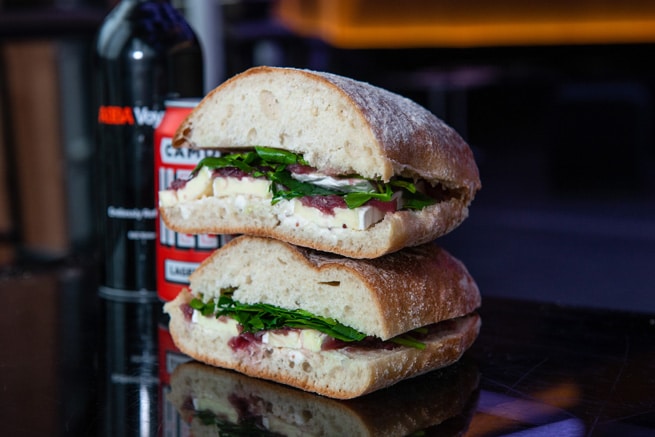
The ABBA Arena has a great variety of food and drink options for you to enjoy. There are bars located throughout the concourse serving a wide range of drinks. You’ll also find dedicated food service areas, offering a seasonal selection of hot & cold options for you to choose from, as well as a selection of drinks, so there’s no need to queue twice.
Did you know you can order ahead and have drinks waiting for you on arrival at the ABBA Arena? It couldn’t be easier.
Upgrade to the ultimate ABBA Voyage experience with access to the exclusive Oceanbird Lounge.
The Oceanbird Lounge is a premium space within the ABBA Arena, where you can relax and enjoy free flowing drinks – including a Oceanbird-themed cocktail ahead of the concert. The lounge also serves cold-cuts and platters, snacks, and desserts. Elevate your ABBA experience, and make your voyage a trip to remember.
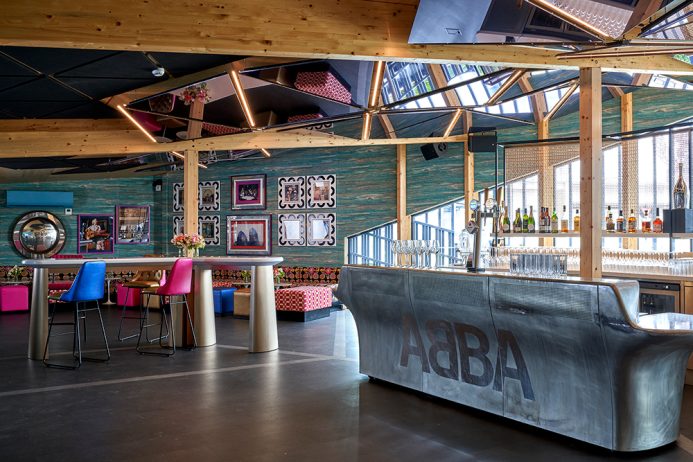
The Oceanbird Lounge is available to all concertgoers. Simply add Oceanbird Lounge access when booking your tickets, or purchase a lounge pass separately. When purchasing separately, please ensure you select the performance you will be attending.
The Oceanbird Lounge is named after our partner.
Oceanbird Lounge Benefits:

Priority Entry
Skip the queues when you arrive with a fast-track entrance into the ABBA Arena.

Arrive Early
Experience the Oceanbird Lounge 1 hour 45 minutes prior to the concert.

Indulge in a variety of food options. Food offerings vary depending on the performance you have booked for.

Unlimited drinks, all served to you by our welcoming staff, including prosecco, wine, beer, draft cocktails and soft drinks.

On-site Merch
At the ABBA Arena we have two on-site shops where you can purchase official ABBA Voyage merchandise. There is one located inside the ABBA Arena and one at Pudding Mill Lane station.
Frequently Asked Questions
Looking for more information? Take a look at our frequently asked questions.
Added to your basket
Unwrap More Than Chocolate: Easter Adventures Await!

Find Hidden Treasure in...
Pudding Lane to Pye Corner
Treasure hunt trail.

Treasure Hunt
Are you ready to explore London?
Things are heating up on this quest!
Show More »
Your self-guided treasure hunt begins at the Monument to the Great Fire of London, near where the fire broke out, and ends at Farringdon, beyond where it was finally extinguished. You'll track down vital clues, unlock fascinating facts and discover references to the Great Fire as you advance, so stay alert!
Can you unearth the historical hoard?
As the fire spread across the city of London from the little bakery in Pudding Lane, treasure from the churches was carted to Farringdon to make sure it didn't melt in the blaze. Eventually, MOST of the precious items were returned. But not all! We need YOU to locate the lost loot likely pilfered by light-fingered merchant Nick Stuffe, who suspiciously profited from the chaos. Good luck!
The Details
- A self-guided treasure hunt walking Trail from Pudding Lane to Pye Corner.
- Ideal for kids aged 6 – 106!
- 2-mile ’linear’ Trail (takes 2 hours to complete at your own pace, plus the return journey).
- Text message service with clues if you get stuck.
- Solve the quest and be entered into a £100 monthly draw.
- Learn more about where you live or explore somewhere new.
- Download your Trail now for INSTANT FUN (or receive your copy in the post)!
Please choose your Trail format:
Want instant access to adventure? Enjoy your Trail on the brand new Treasure Trails App, or print at home, if you'd prefer.
Want us to send you the printed version? Have a high quality Trail booklet delivered, first class, straight to your door.
Proceed to Checkout
has been added to your basket
Don't forget to change the title of your Trail
Don't forget to upload an image for your Trail
Adding product to your Basket
- Share Share on Facebook
- Tweet Tweet on X
- Pin it Pin on Pinterest
The Pudding Lane to Pye Corner Treasure Trail starts at:
The Monument to the Great Fire of London
Monument Square
We have three super duper themed Clubs for your child to enjoy as part of their Treasure Trail experience.
Perfect for 4-8 year olds, the concept behind the Clubs is that your child will get a bundle of goodies to excite them about their forthcoming Trail experience, something to keep them entertained whilst travelling to and from the Trail, and something to be given on completion of the Trail as a keepsake. Show more »
Before you set off on your awesome adventure to explore Pudding Lane to Pye Corner, there are a few things you need to know...
The route is friendly for wheelchair users and pushchairs.
This Trail takes you through a very busy city centre, so we would not recommend bringing your four-legged friends along.
This Trail starts close to Monument Underground Station on the Circle and District lines, and ends close to Farringdon Station, which is on the main line as well as the Circle, Hammersmith & City, Metropolitan and Elizabeth Underground lines.
Access may be restricted to some parts of the Trail on some days due to special events or marches in central London. It's always best to check for known road closures and restrictions ahead of travel.
There are public toilets available at several spots along the route, and you’ll pass plenty of snack shops, cafes, pubs, restaurants and green spaces as you go.
Looking for more things to do near Pudding Lane and Pye Corner? Make a day of it and unleash your inner daring detective on the City of London – Pudding Lane detective mystery Trail. Or, try one of the other Trails in our London collection.
Customer Reviews

Treat your inbox
Receive our newsletter on the latest offers and happenings. You can unsubscribe any time you want.
- Choosing a selection results in a full page refresh.
- Press the space key then arrow keys to make a selection.

COMMENTS
Great Fire of London locations: Need to know. If you want to climb the Monument, with adult tickets costing £5.40, and £2.70 for children aged five to 15 (take cash to be on the safe side). You can also get joint tickets for the Monument and the Tower Bridge Exhibition, for £12.80 and £6.40, as well as family tickets.
The slab was discovered in the yard of 25 Pudding Lane in 1876 during construction work and later displayed at the Museum of London where you can go and see it today. Tin-glazed floor tiles were discovered during excavations of the cellar of a Pudding Lane shop destroyed in the Great Fire of London.
(See an earlier article for a "secret" bit of Pudding Lane that'll take you up through the neighbouring buildings and out to the Thames.) 3. The "real" location where the Great Fire started
244. Pudding Lane sign Fred Cherrygarden (Atlas Obscura User) The Great Fire of London started on September 2, 1666 from Thomas Farriner's bakery on Pudding Lane. The fire burned down about 85 ...
Pudding Lane - The Great Fire of London. Where? Pudding Lane, The City EC3 Time required? A typical visit is 2 mins Parking: Nearby car parks Buses: 17, 521, 21, 43, 133, 141, 48, 149 ... There's nothing much to see in Pudding Lane nowadays other than The Monument next-door. It's decorated with heavy metal shutters, courier bikes ...
The official Monument website offers great resources for visitors including schools, who want to learn more about the Great Fire of 1666. Your guide to one of the City's best-loved attractions, the Monument offers panoramic views over London. It was built to commemorate the Great Fire which devastated the City of London in 1666.
The Great Fire of London 1666. On 2 September 1666, an event started that would change the face of London. The Great Fire broke out from a baker's house in Pudding Lane. By the time it was over four days later, much of the medieval city lay in smoking ruins. These objects from our collections tell the story of the Great Fire.
Visit the Monument. The Monument to the Great Fire of London is open daily from 09:30-13:00 and 14:00-18:00*. Last entry is at 12:30 and 17:30. On certain occasions, when we are unable to open The Monument, we will always include an alert on this website. So please check on the day of travel to ensure that we are open.
The exact spot of the oven where it started was discovered in 2016 by archaeologists. It is in the southern lane of what is now Monument Street, about 60ft east of Pudding Lane, but which was once a part of the original Pudding Lane. Incidentally, the Pudding in Pudding Lane does not refer to sweet treats, but to blood pudding - the offal from ...
Pudding Lane is a small street in London, widely known as the location of Thomas Farriner's bakery, ... In the 1982 Doctor Who episode "The Visitation", aliens visit 17th century London and cause an explosion in Pudding Lane, which is revealed to be the true source of the Great Fire. References Bibliography. Collins, Amy (2016). ...
The Monument stands 202 feet (61 metres) in height and 202 feet (61 metres) to the west of the spot where the Great Fire started on Pudding Lane; 311 spiral steps lead up to the public viewing platform, where visitors can get breath-taking views of London from 160 feet (48.7 metres) above ground
Pudding Lane. Just down the road from the Monument is Pudding Lane, the source of the great fire. The only reminder nowadays is a small plaque on one of the buildings. The road itself is nothing special, I think a new bakery would be a great addition! Pudding Lane All Hallows by the Tower. All Hallows by the Tower is the oldest church in London.
Sir Christopher Wren's flame-topped Monument to the Great Fire of 1666 is the tallest isolated stone column in the world. Completed in 1677, The Monument stands 202 feet high (61 meters) and is positioned 202 feet (61 meters) from the spot on Pudding Lane where the Great Fire of London is believed to have started.
A small London street between Eastcheap and Thames Street, Pudding Lane was made infamous in 1666 when Thomas Farriner's bakery caught alight in a blaze that would go on to destroy 85% of medieval London. It was around midnight on the 2nd of September when the fire first started to spread. The best firefighting practices of the time would have ...
If you don't know much London history, then the Great Fire of London took place in 1666. It started a baker's house on Pudding Lane, quickly spiralling out of control. A little known fact is that Pudding Lane isn't named for sweet desserts but because 'pudding' is a medieval word for offal (the entrails of a butchered animal).
The Monument surrounded by modern buildings. London has changed a lot over the decades and centuries. But one of its quickest transformations happened in 1666 when a small fire started at a bakery in Pudding Lane near to London Bridge. Four days later it had destroyed most of medieval London including the old St Paul's Cathedral.
8 See also. 9 Notes. 10 References. 11 Further reading. ... The Monument to the Great Fire of London, more commonly known simply as the Monument, ... 202 feet (62 m) in height and 202 feet west of the spot in Pudding Lane where the Great Fire started on 2 September 1666. Constructed between 1671 and 1677, it was built on the site of St Margaret
Welcome to The Monument. The official website for The Monument, one of the City's most-loved attractions, which offers panoramic views over London. The 202ft column, designed by Sir Christopher Wren and Dr Robert Hooke, was built to commemorate the Great Fire of 1666 and stands on the piazza between Fish Street Hill and Monument Street.
The Great Fire of London started in at a bakery in Pudding Lane, an unassuming street in the heart of the City of London. The King's baker, Thomas Farrier, lived and worked at the Pudding Lane bakery. To get to Pudding Lane, go to Monument station on the circle and district lines. It's unclear exactly how the fire started.
Start the day at the Pudding Lane sign which is modern now but still exciting for kids learning about the fire. You can even find a plaque on pudding lane saying this is where the fire started. It's small, quaint street widely known as the location of Thomas Farriner's bakery where the Great Fire of London started in 1666.
Here, you can expect excellent views of St Magnus the Martyr church (above). This church is a fascinating place to visit in its own right. Old London Bridge passed right underneath its porch.
Doors to the ABBA Arena open 1 hour 45 minutes before the concert, so you can arrive early to make the most of our bar and food outlets which will all be open before the concert starts. If you arrive within the first hour of the Arena opening, take advantage of our Early Arrivals combo for just £14.95. Choose from a hot dog or burrito, plus ...
A self-guided treasure hunt walking Trail from Pudding Lane to Pye Corner. Ideal for kids aged 6 - 106! 2-mile 'linear' Trail (takes 2 hours to complete at your own pace, plus the return journey). Text message service with clues if you get stuck. Solve the quest and be entered into a £100 monthly draw.